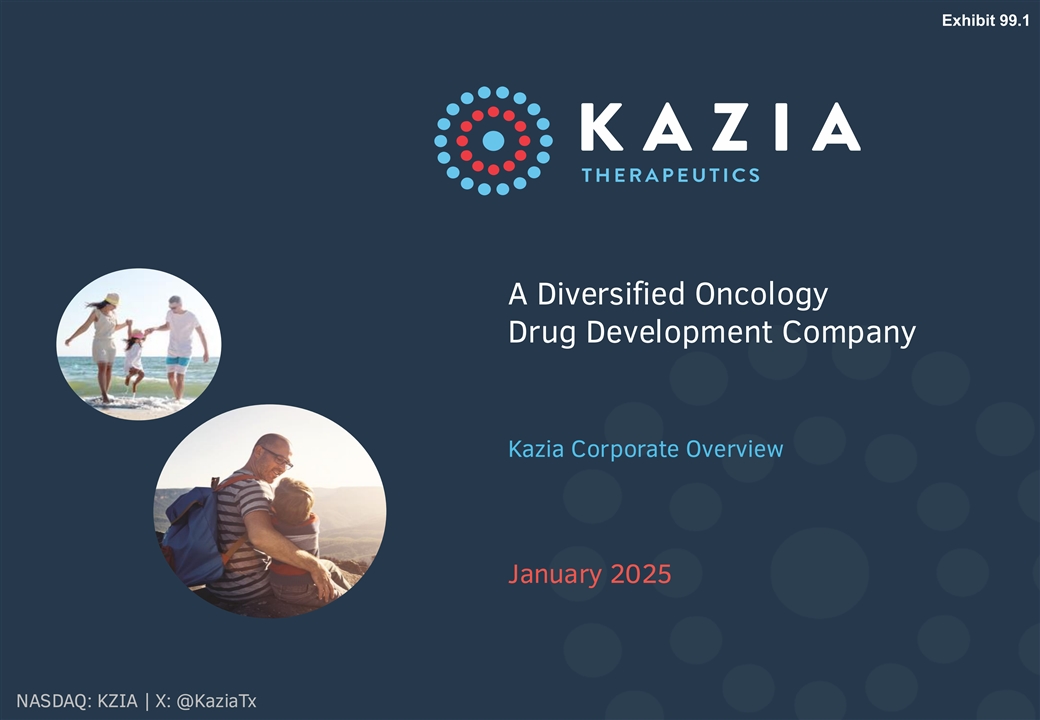
Exhibit 99.1 A Diversified Oncology Drug Development Company Kazia Corporate Overview January 2025 NASDAQ: KZIA | X: @KaziaTx
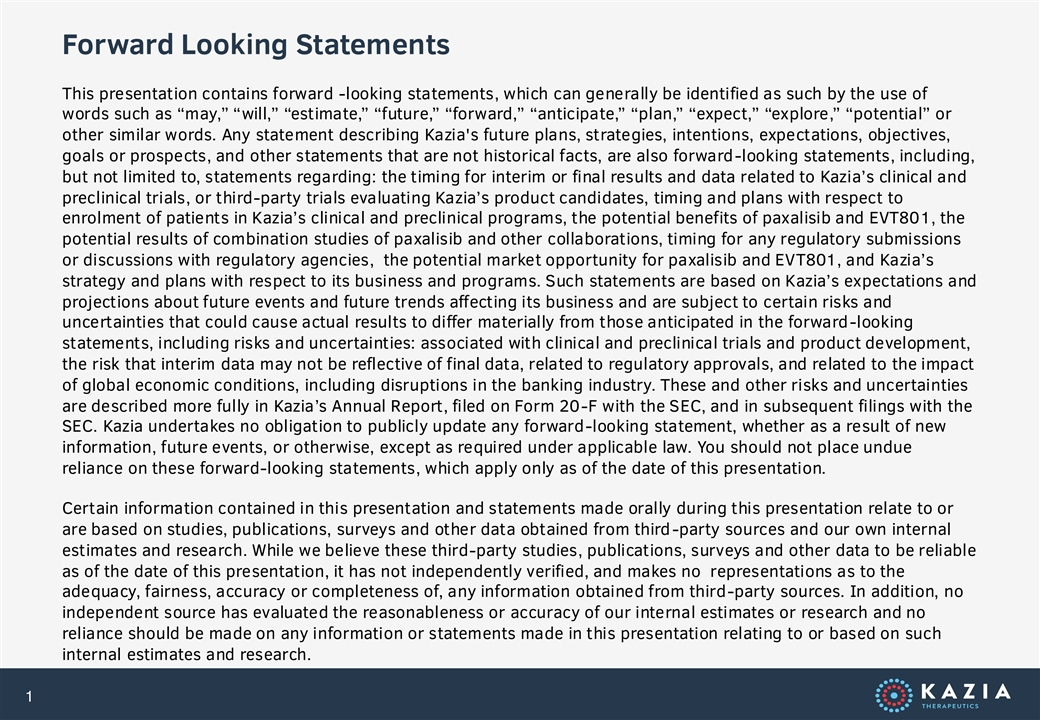
Forward Looking Statements This presentation contains forward -looking statements, which can generally be identified as such by the use of words such as “may,” “will,” “estimate,” “future,” “forward,” “anticipate,” “plan,” “expect,” “explore,” “potential” or other similar words. Any statement describing Kazia's future plans, strategies, intentions, expectations, objectives, goals or prospects, and other statements that are not historical facts, are also forward-looking statements, including, but not limited to, statements regarding: the timing for interim or final results and data related to Kazia’s clinical and preclinical trials, or third-party trials evaluating Kazia’s product candidates, timing and plans with respect to enrolment of patients in Kazia’s clinical and preclinical programs, the potential benefits of paxalisib and EVT801, the potential results of combination studies of paxalisib and other collaborations, timing for any regulatory submissions or discussions with regulatory agencies, the potential market opportunity for paxalisib and EVT801, and Kazia’s strategy and plans with respect to its business and programs. Such statements are based on Kazia’s expectations and projections about future events and future trends affecting its business and are subject to certain risks and uncertainties that could cause actual results to differ materially from those anticipated in the forward-looking statements, including risks and uncertainties: associated with clinical and preclinical trials and product development, the risk that interim data may not be reflective of final data, related to regulatory approvals, and related to the impact of global economic conditions, including disruptions in the banking industry. These and other risks and uncertainties are described more fully in Kazia’s Annual Report, filed on Form 20-F with the SEC, and in subsequent filings with the SEC. Kazia undertakes no obligation to publicly update any forward-looking statement, whether as a result of new information, future events, or otherwise, except as required under applicable law. You should not place undue reliance on these forward-looking statements, which apply only as of the date of this presentation. Certain information contained in this presentation and statements made orally during this presentation relate to or are based on studies, publications, surveys and other data obtained from third-party sources and our own internal estimates and research. While we believe these third-party studies, publications, surveys and other data to be reliable as of the date of this presentation, it has not independently verified, and makes no representations as to the adequacy, fairness, accuracy or completeness of, any information obtained from third-party sources. In addition, no independent source has evaluated the reasonableness or accuracy of our internal estimates or research and no reliance should be made on any information or statements made in this presentation relating to or based on such internal estimates and research. 1
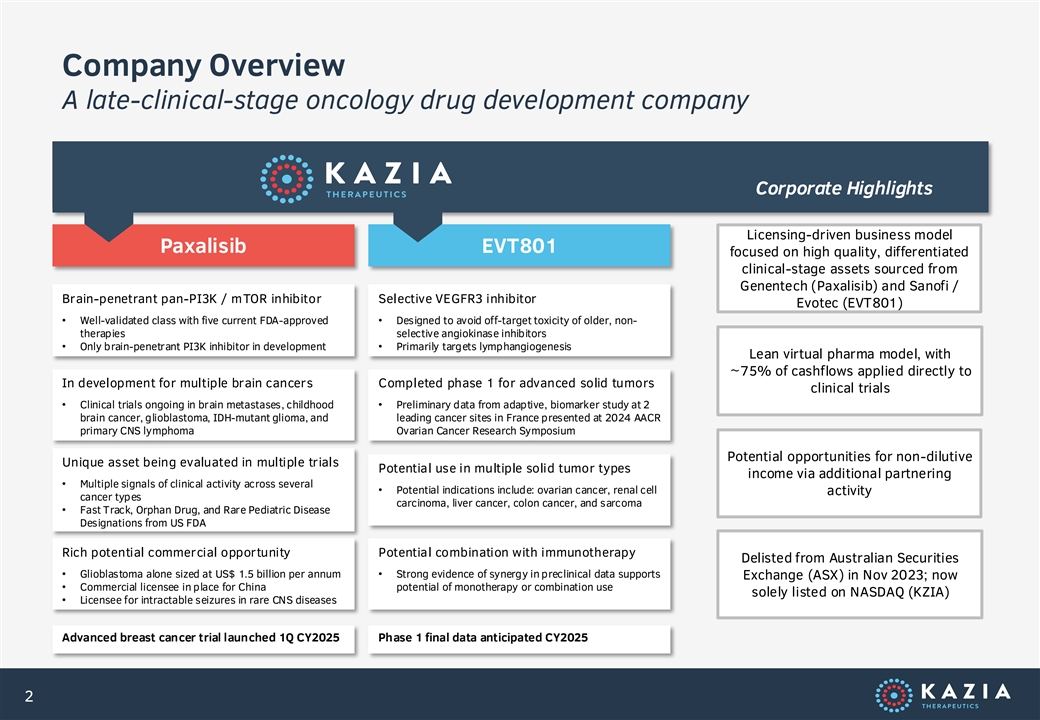
Company Overview A late-clinical-stage oncology drug development company Corporate Highlights Licensing-driven business model Paxalisib EVT801 focused on high quality, differentiated clinical-stage assets sourced from Genentech (Paxalisib) and Sanofi / Brain-penetrant pan-PI3K / mTOR inhibitor Selective VEGFR3 inhibitor Evotec (EVT801) • Well-validated class with five current FDA-approved • Designed to avoid off-target toxicity of older, non- therapies selective angiokinase inhibitors • Only brain-penetrant PI3K inhibitor in development• Primarily targets lymphangiogenesis Lean virtual pharma model, with ~75% of cashflows applied directly to In development for multiple brain cancers Completed phase 1 for advanced solid tumors clinical trials • Clinical trials ongoing in brain metastases, childhood • Preliminary data from adaptive, biomarker study at 2 brain cancer, glioblastoma, IDH-mutant glioma, and leading cancer sites in France presented at 2024 AACR primary CNS lymphoma Ovarian Cancer Research Symposium Potential opportunities for non-dilutive Unique asset being evaluated in multiple trials Potential use in multiple solid tumor types income via additional partnering • Multiple signals of clinical activity across several • Potential indications include: ovarian cancer, renal cell activity cancer types carcinoma, liver cancer, colon cancer, and sarcoma • Fast Track, Orphan Drug, and Rare Pediatric Disease Designations from US FDA Rich potential commercial opportunity Potential combination with immunotherapy Delisted from Australian Securities • Glioblastoma alone sized at US$ 1.5 billion per annum• Strong evidence of synergy in preclinical data supports Exchange (ASX) in Nov 2023; now • Commercial licensee in place for China potential of monotherapy or combination use solely listed on NASDAQ (KZIA) • Licensee for intractable seizures in rare CNS diseases Advanced breast cancer trial launched 1Q CY2025 Phase 1 final data anticipated CY2025 2
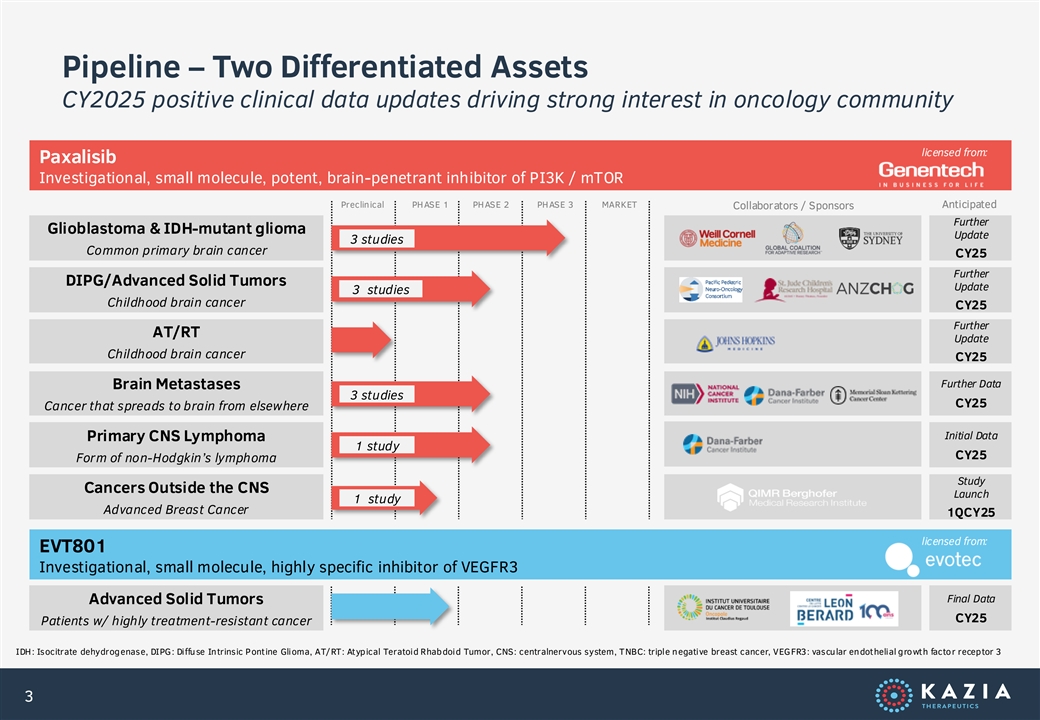
Pipeline – Two Differentiated Assets CY2025 positive clinical data updates driving strong interest in oncology community licensed from: Paxalisib Investigational, small molecule, potent, brain-penetrant inhibitor of PI3K / mTOR Preclinical PHASE 1 PHASE 2 PHASE 3 MARKET Anticipated Collaborators / Sponsors Further Glioblastoma & IDH-mutant glioma Update 3 studies Common primary brain cancer CY25 Further DIPG/Advanced Solid Tumors Update 3 studies Childhood brain cancer CY25 Further AT/RT Update Childhood brain cancer CY25 Further Data Brain Metastases 3 studies CY25 Cancer that spreads to brain from elsewhere Initial Data Primary CNS Lymphoma 1 study CY25 Form of non-Hodgkin’s lymphoma Study Cancers Outside the CNS Launch 1 study Advanced Breast Cancer 1QCY25 licensed from: EVT801 Investigational, small molecule, highly specific inhibitor of VEGFR3 Final Data Advanced Solid Tumors CY25 Patients w/ highly treatment-resistant cancer IDH: Isocitrate dehydrogenase, DIPG: Diffuse Intrinsic Pontine Glioma, AT/RT: Atypical Teratoid Rhabdoid Tumor, CNS: central nervous system, TNBC: triple negative breast cancer, VEGFR3: vascular endothelial growth factor receptor 3 3
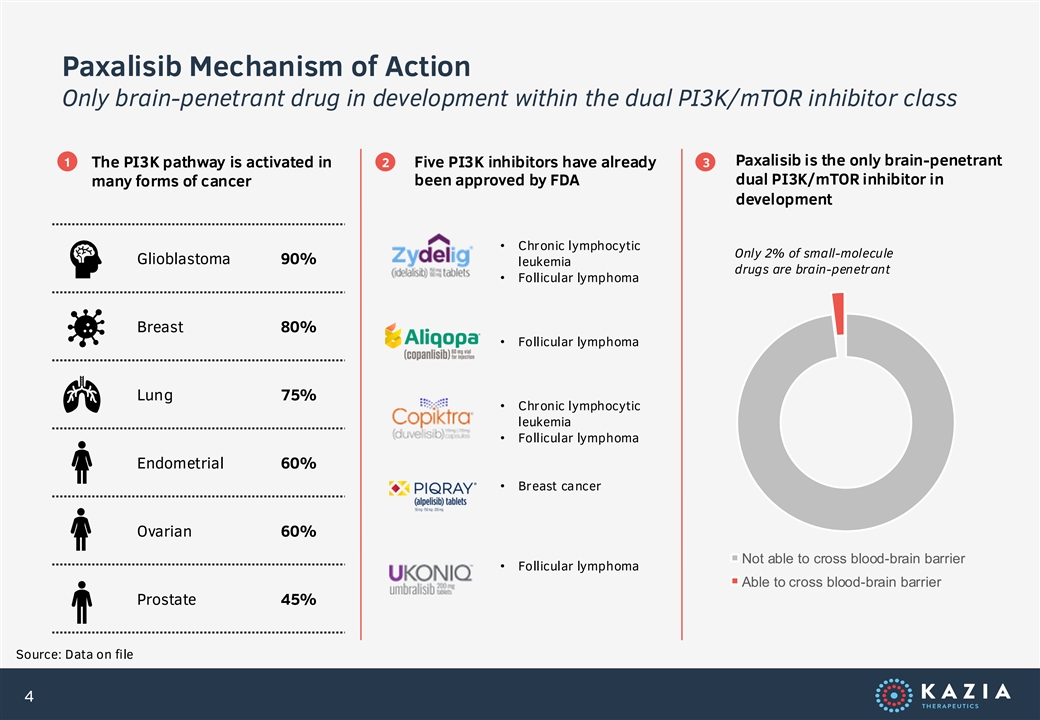
Paxalisib Mechanism of Action Only brain-penetrant drug in development within the dual PI3K/mTOR inhibitor class Paxalisib is the only brain-penetrant 1 The PI3K pathway is activated in 2 Five PI3K inhibitors have already 3 been approved by FDA dual PI3K/mTOR inhibitor in many forms of cancer development • Chronic lymphocytic Only 2% of small-molecule Glioblastoma 90% leukemia drugs are brain-penetrant • Follicular lymphoma Breast 80% • Follicular lymphoma Lung 75% • Chronic lymphocytic leukemia • Follicular lymphoma Endometrial 60% • Breast cancer Ovarian 60% Not able to cross blood-brain barrier • Follicular lymphoma Able to cross blood-brain barrier Prostate 45% Source: Data on file 4
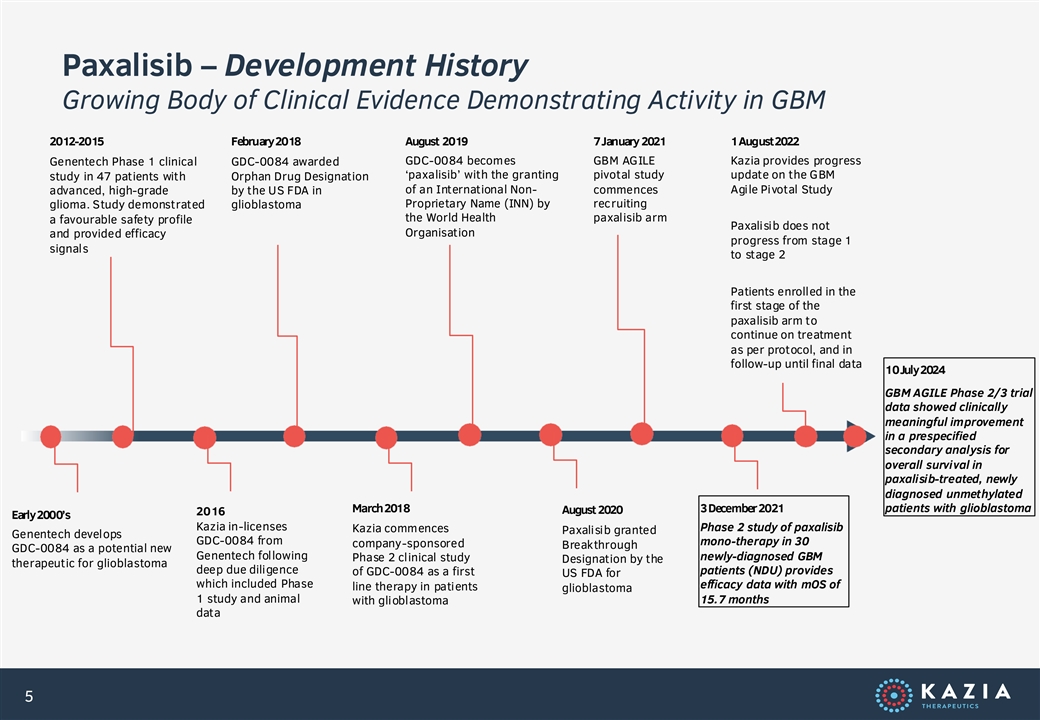
Paxalisib – Development History Growing Body of Clinical Evidence Demonstrating Activity in GBM 2012-2015 February 2018 August 2019 7 January 2021 1 August 2022 Genentech Phase 1 clinical GDC-0084 awarded GDC-0084 becomes GBM AGILE Kazia provides progress ‘paxalisib’ with the granting pivotal study update on the GBM study in 47 patients with Orphan Drug Designation of an International Non- commences Agile Pivotal Study advanced, high-grade by the US FDA in Proprietary Name (INN) by recruiting glioma. Study demonstrated glioblastoma the World Health paxalisib arm a favourable safety profile Paxalisib does not and provided efficacy Organisation progress from stage 1 signals to stage 2 Patients enrolled in the first stage of the paxalisib arm to continue on treatment as per protocol, and in follow-up until final data 10 July 2024 GBM AGILE Phase 2/3 trial data showed clinically meaningful improvement in a prespecified secondary analysis for overall survival in paxalisib-treated, newly diagnosed unmethylated March 2018 3 December 2021 patients with glioblastoma August 2020 2016 Early 2000’s Kazia in-licenses Kazia commences Phase 2 study of paxalisib Paxalisib granted Genentech develops GDC-0084 from mono-therapy in 30 company-sponsored Breakthrough GDC-0084 as a potential new Genentech following newly-diagnosed GBM Phase 2 clinical study Designation by the therapeutic for glioblastoma deep due diligence patients (NDU) provides of GDC-0084 as a first US FDA for which included Phase efficacy data with mOS of line therapy in patients glioblastoma 1 study and animal 15.7 months with glioblastoma data 5

Glioblastoma Background & Market potential 6
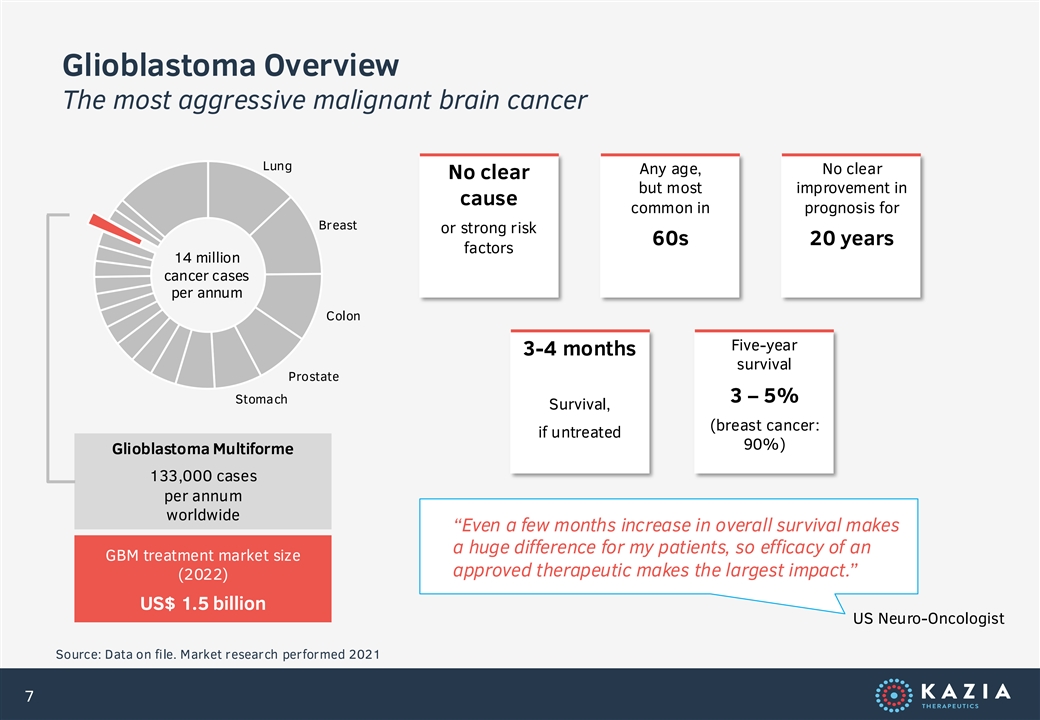
Glioblastoma Overview The most aggressive malignant brain cancer Lung Any age, No clear No clear but most improvement in cause common in prognosis for Breast or strong risk 60s 20 years factors 14 million cancer cases per annum Colon Five-year 3-4 months survival Prostate 3 – 5% Stomach Survival, (breast cancer: if untreated 90%) Glioblastoma Multiforme 133,000 cases per annum worldwide “Even a few months increase in overall survival makes a huge difference for my patients, so efficacy of an GBM treatment market size approved therapeutic makes the largest impact.” (2022) US$ 1.5 billion US Neuro-Oncologist Source: Data on file. Market research performed 2021 7
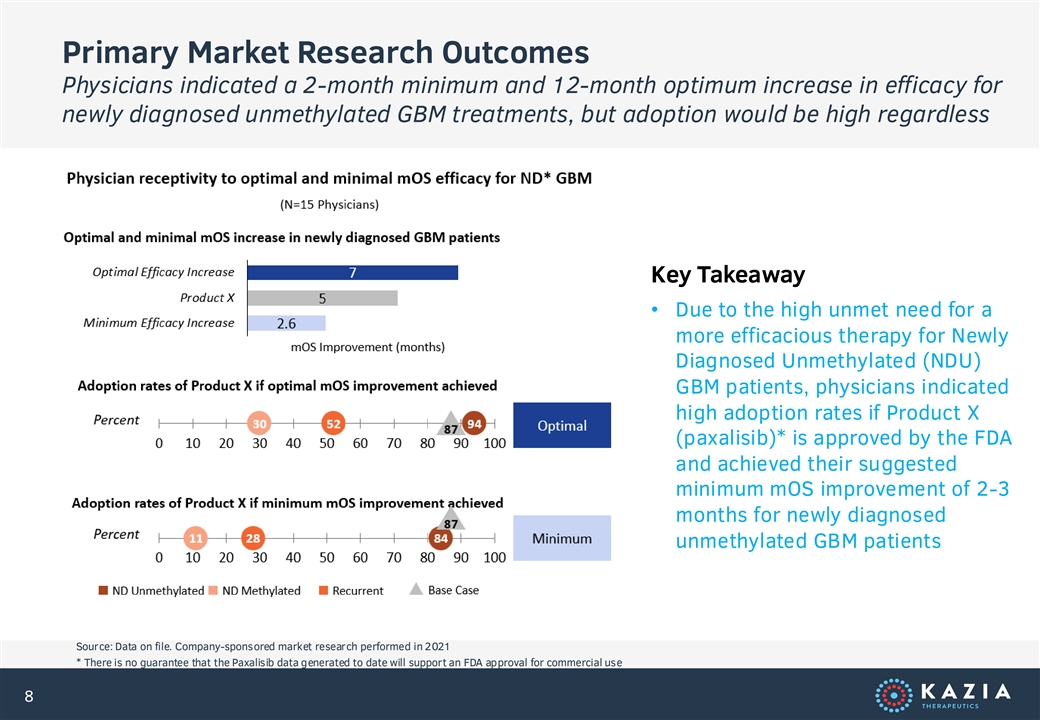
Primary Market Research Outcomes Physicians indicated a 2-month minimum and 12-month optimum increase in efficacy for newly diagnosed unmethylated GBM treatments, but adoption would be high regardless Key Takeaway • Due to the high unmet need for a more efficacious therapy for Newly Diagnosed Unmethylated (NDU) GBM patients, physicians indicated high adoption rates if Product X (paxalisib)* is approved by the FDA and achieved their suggested minimum mOS improvement of 2-3 months for newly diagnosed unmethylated GBM patients Source: Data on file. Company-sponsored market research performed in 2021 * There is no guarantee that the Paxalisib data generated to date will support an FDA approval for commercial use 8
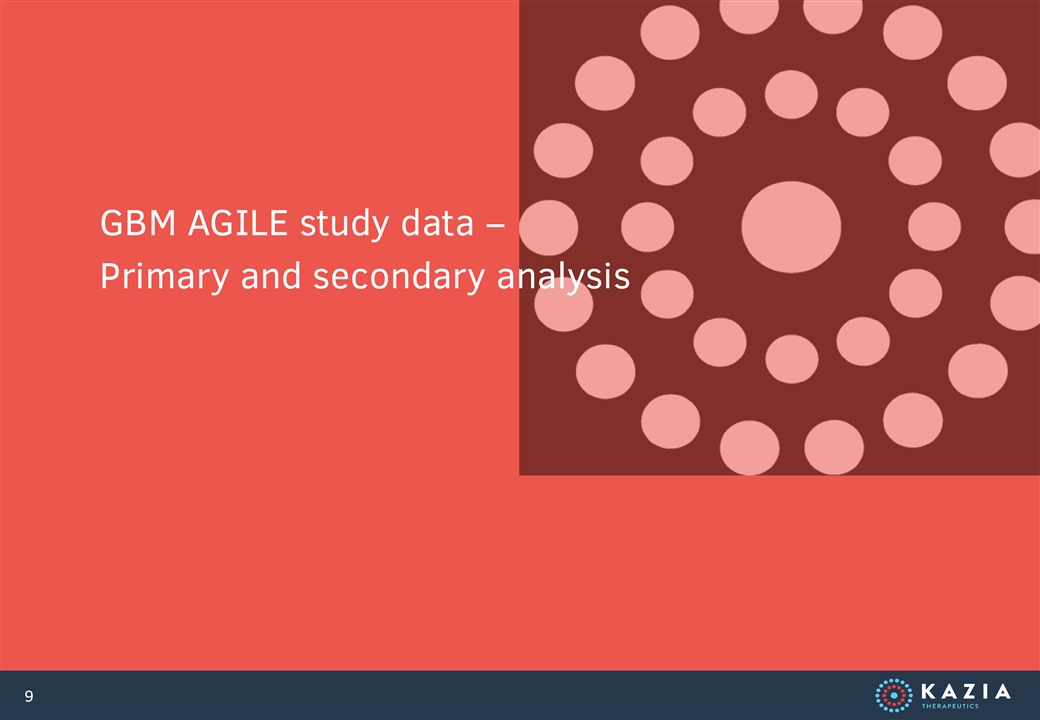
GBM AGILE study data – Primary and secondary analysis 9
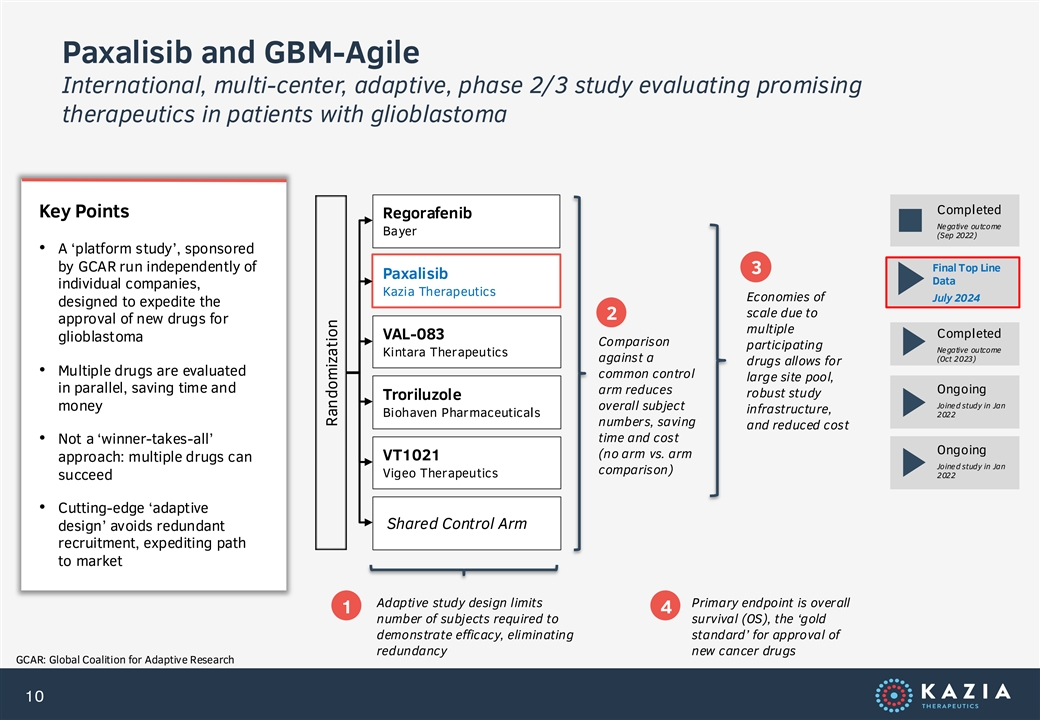
Paxalisib and GBM-Agile International, multi-center, adaptive, phase 2/3 study evaluating promising therapeutics in patients with glioblastoma Completed Key Points Regorafenib Negative outcome Bayer (Sep 2022) • A ‘platform study’, sponsored by GCAR run independently of Final Top Line 3 Paxalisib Data individual companies, Kazia Therapeutics Economies of July 2024 designed to expedite the scale due to 2 approval of new drugs for multiple Completed VAL-083 glioblastoma Comparison participating Negative outcome Kintara Therapeutics against a (Oct 2023) drugs allows for • Multiple drugs are evaluated common control large site pool, in parallel, saving time and Ongoing arm reduces robust study Troriluzole Joined study in Jan money overall subject infrastructure, Biohaven Pharmaceuticals 2022 numbers, saving and reduced cost time and cost • Not a ‘winner-takes-all’ Ongoing (no arm vs. arm VT1021 approach: multiple drugs can Joined study in Jan comparison) Vigeo Therapeutics 2022 succeed • Cutting-edge ‘adaptive Shared Control Arm design’ avoids redundant recruitment, expediting path to market Adaptive study design limits Primary endpoint is overall 1 4 number of subjects required to survival (OS), the ‘gold demonstrate efficacy, eliminating standard’ for approval of redundancy new cancer drugs GCAR: Global Coalition for Adaptive Research 10 Randomization
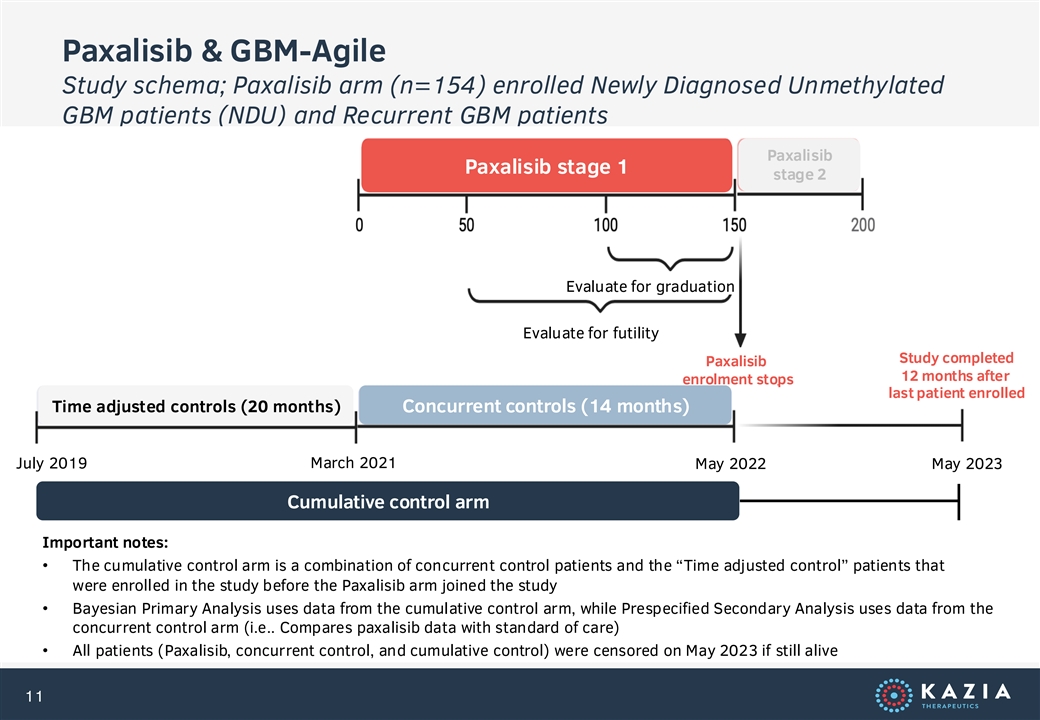
Paxalisib & GBM-Agile Study schema; Paxalisib arm (n=154) enrolled Newly Diagnosed Unmethylated GBM patients (NDU) and Recurrent GBM patients Paxalisib Paxalisib stage 1 stage 2 Evaluate for graduation Evaluate for futility Study completed Paxalisib 12 months after enrolment stops last patient enrolled Time adjusted controls (20 months) Concurrent controls (14 months) March 2021 July 2019 May 2022 May 2023 Cumulative control arm Important notes: • The cumulative control arm is a combination of concurrent control patients and the “Time adjusted control” patients that were enrolled in the study before the Paxalisib arm joined the study • Bayesian Primary Analysis uses data from the cumulative control arm, while Prespecified Secondary Analysis uses data from the concurrent control arm (i.e.. Compares paxalisib data with standard of care) • All patients (Paxalisib, concurrent control, and cumulative control) were censored on May 2023 if still alive 11
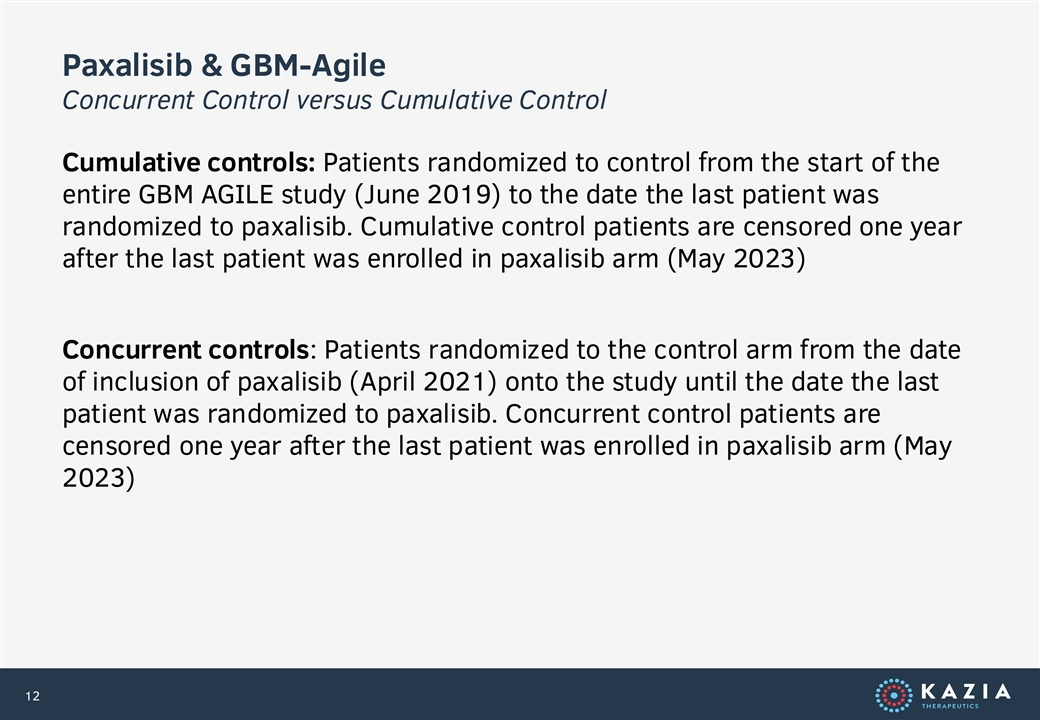
Paxalisib & GBM-Agile Concurrent Control versus Cumulative Control Cumulative controls: Patients randomized to control from the start of the entire GBM AGILE study (June 2019) to the date the last patient was randomized to paxalisib. Cumulative control patients are censored one year after the last patient was enrolled in paxalisib arm (May 2023) Concurrent controls: Patients randomized to the control arm from the date of inclusion of paxalisib (April 2021) onto the study until the date the last patient was randomized to paxalisib. Concurrent control patients are censored one year after the last patient was enrolled in paxalisib arm (May 2023) 12
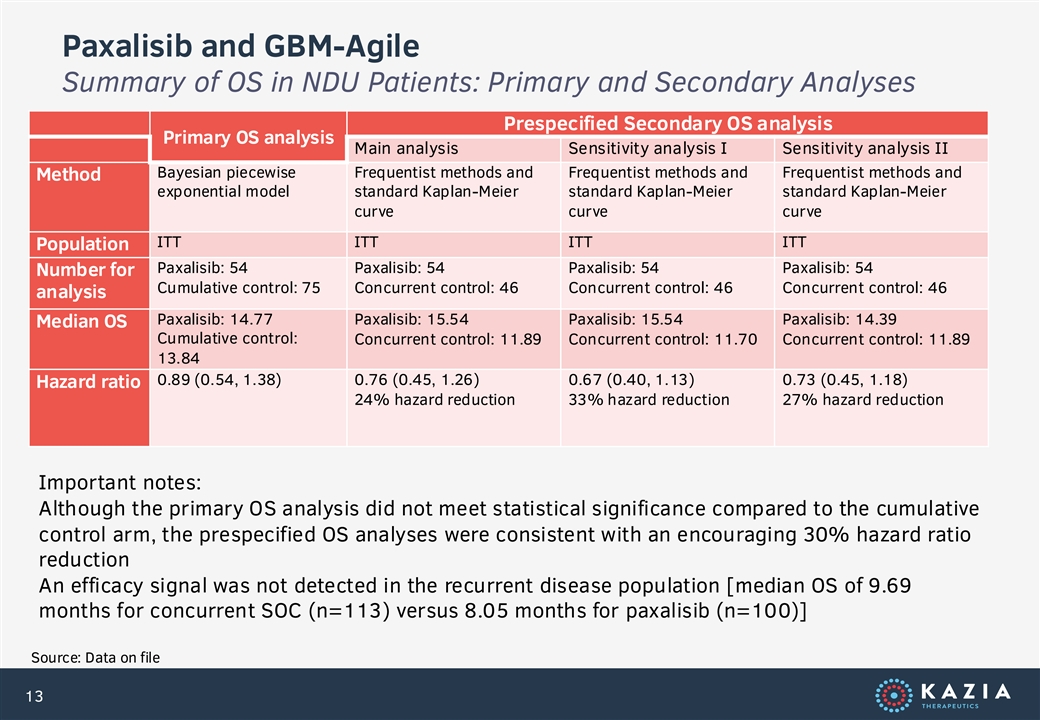
Paxalisib and GBM-Agile Summary of OS in NDU Patients: Primary and Secondary Analyses Prespecified Secondary OS analysis Primary OS analysis Main analysis Sensitivity analysis I Sensitivity analysis II Bayesian piecewise Frequentist methods and Frequentist methods and Frequentist methods and Method exponential model standard Kaplan-Meier standard Kaplan-Meier standard Kaplan-Meier curve curve curve ITT ITT ITT ITT Population Paxalisib: 54 Paxalisib: 54 Paxalisib: 54 Paxalisib: 54 Number for Cumulative control: 75 Concurrent control: 46 Concurrent control: 46 Concurrent control: 46 analysis Paxalisib: 14.77 Paxalisib: 15.54 Paxalisib: 15.54 Paxalisib: 14.39 Median OS Cumulative control: Concurrent control: 11.89 Concurrent control: 11.70 Concurrent control: 11.89 13.84 0.89 (0.54, 1.38) 0.76 (0.45, 1.26) 0.67 (0.40, 1.13) 0.73 (0.45, 1.18) Hazard ratio 24% hazard reduction 33% hazard reduction 27% hazard reduction Important notes: Although the primary OS analysis did not meet statistical significance compared to the cumulative control arm, the prespecified OS analyses were consistent with an encouraging 30% hazard ratio reduction An efficacy signal was not detected in the recurrent disease population [median OS of 9.69 months for concurrent SOC (n=113) versus 8.05 months for paxalisib (n=100)] Source: Data on file 13
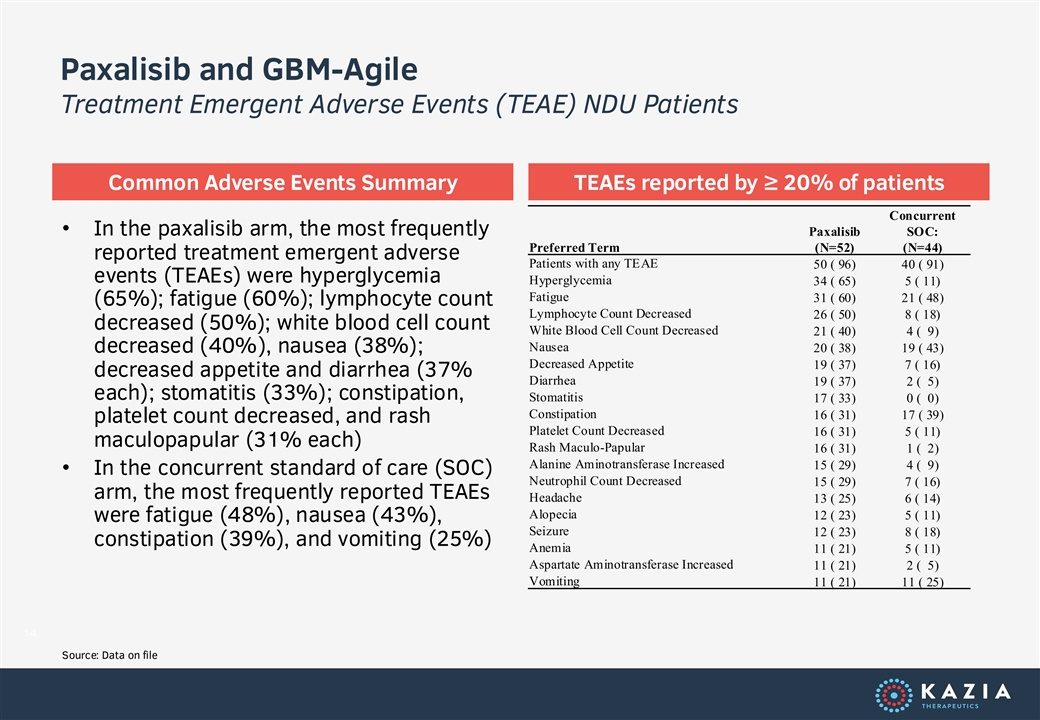
Paxalisib and GBM-Agile Treatment Emergent Adverse Events (TEAE) NDU Patients Common Adverse Events Summary TEAEs reported by ≥ 20% of patients Concurrent • In the paxalisib arm, the most frequently Paxalisib SOC: Preferred Term (N=52) (N=44) reported treatment emergent adverse Patients with any TEAE 50 ( 96) 40 ( 91) events (TEAEs) were hyperglycemia Hyperglycemia 34 ( 65) 5 ( 11) Fatigue 31 ( 60) 21 ( 48) (65%); fatigue (60%); lymphocyte count Lymphocyte Count Decreased 26 ( 50) 8 ( 18) decreased (50%); white blood cell count White Blood Cell Count Decreased 21 ( 40) 4 ( 9) Nausea 20 ( 38) 19 ( 43) decreased (40%), nausea (38%); Decreased Appetite 19 ( 37) 7 ( 16) decreased appetite and diarrhea (37% Diarrhea 19 ( 37) 2 ( 5) each); stomatitis (33%); constipation, Stomatitis 17 ( 33) 0 ( 0) Constipation 16 ( 31) 17 ( 39) platelet count decreased, and rash Platelet Count Decreased 16 ( 31) 5 ( 11) maculopapular (31% each) Rash Maculo-Papular 16 ( 31) 1 ( 2) Alanine Aminotransferase Increased 15 ( 29) 4 ( 9) • In the concurrent standard of care (SOC) Neutrophil Count Decreased 15 ( 29) 7 ( 16) arm, the most frequently reported TEAEs Headache 13 ( 25) 6 ( 14) Alopecia 12 ( 23) 5 ( 11) were fatigue (48%), nausea (43%), Seizure 12 ( 23) 8 ( 18) constipation (39%), and vomiting (25%) Anemia 11 ( 21) 5 ( 11) Aspartate Aminotransferase Increased 11 ( 21) 2 ( 5) Vomiting 11 ( 21) 11 ( 25) 14 Source: Data on file
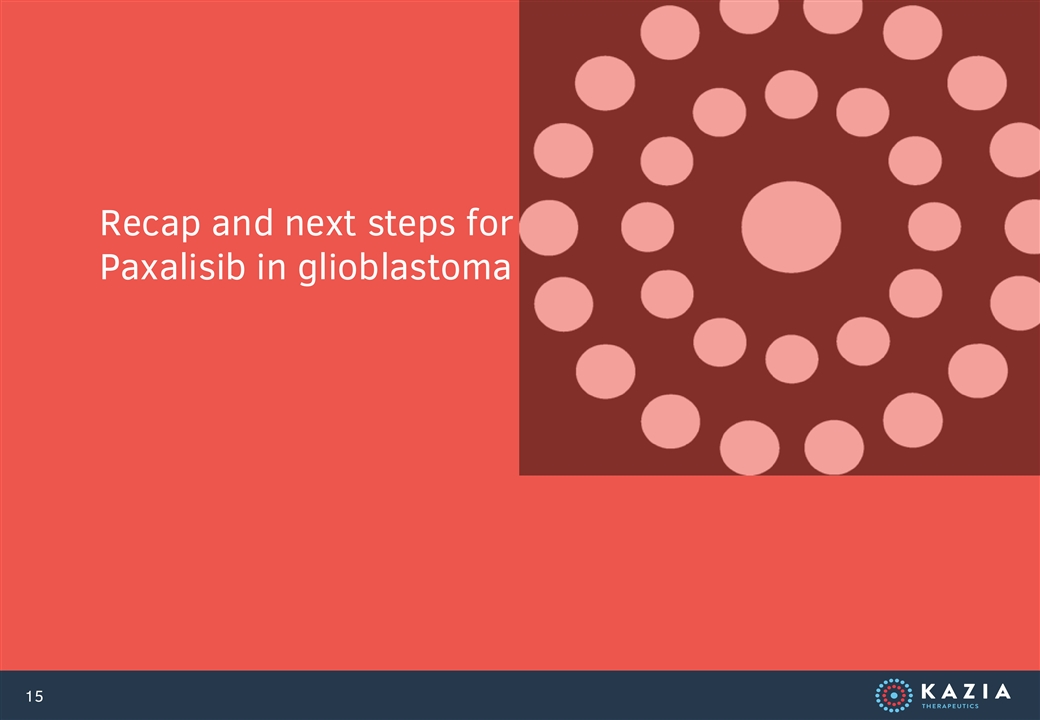
Recap and next steps for Paxalisib in glioblastoma 15
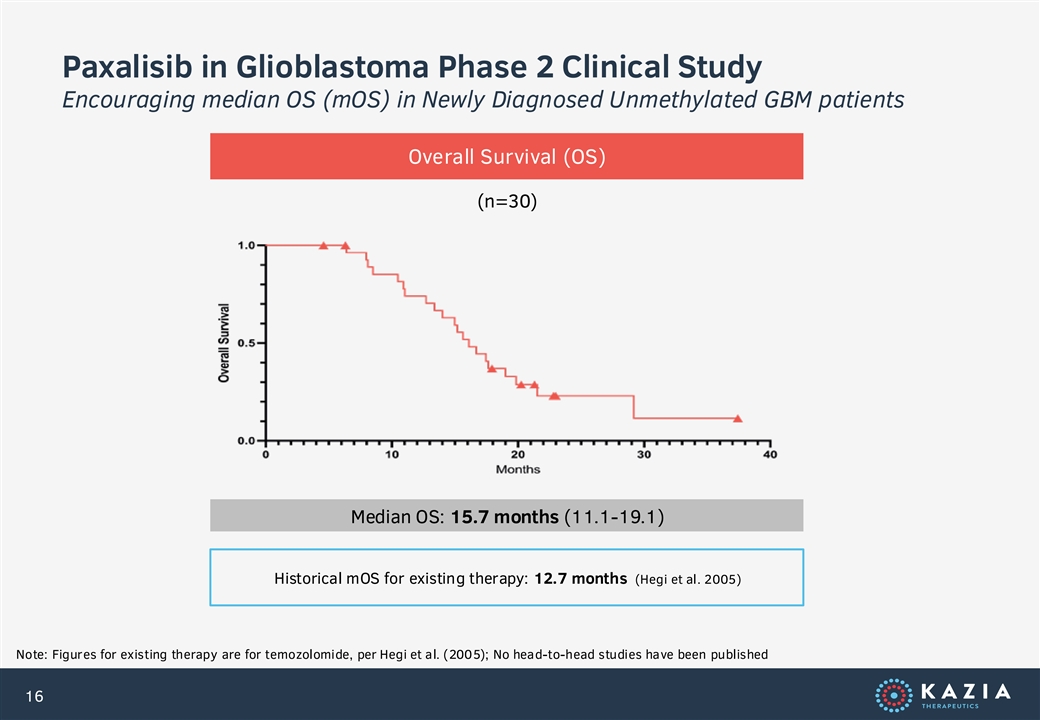
Paxalisib in Glioblastoma Phase 2 Clinical Study Encouraging median OS (mOS) in Newly Diagnosed Unmethylated GBM patients Overall Survival (OS) (n=30) Median OS: 15.7 months (11.1-19.1) Historical mOS for existing therapy: 12.7 months (Hegi et al. 2005) Note: Figures for existing therapy are for temozolomide, per Hegi et al. (2005); No head-to-head studies have been published 16
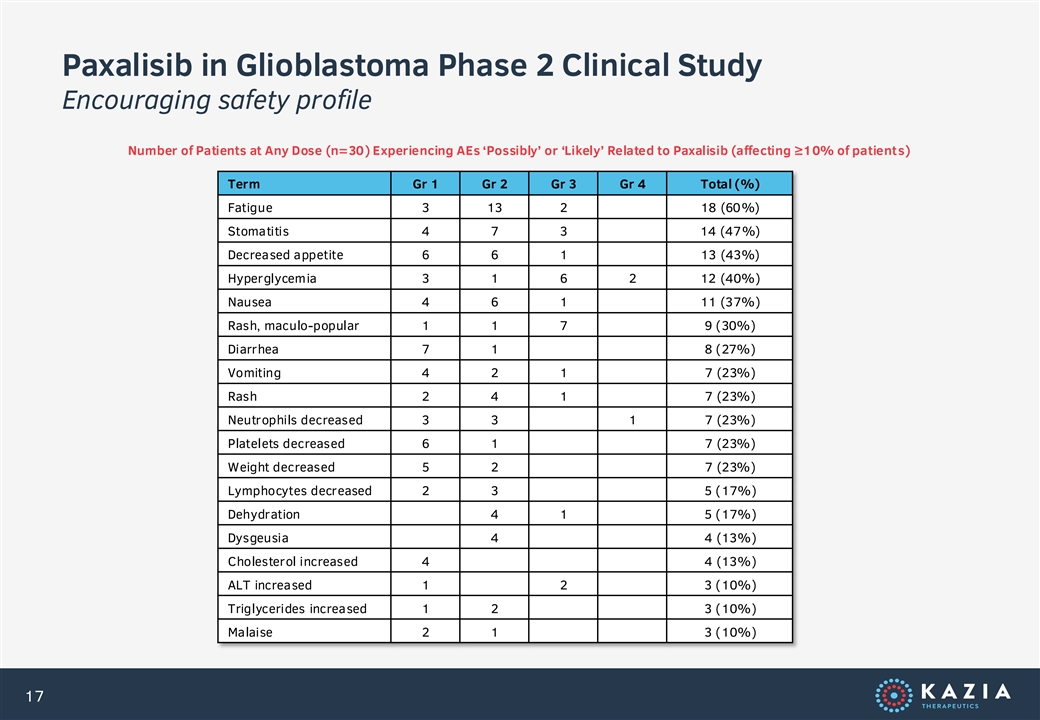
Paxalisib in Glioblastoma Phase 2 Clinical Study Encouraging safety profile Number of Patients at Any Dose (n=30) Experiencing AEs ‘Possibly’ or ‘Likely’ Related to Paxalisib (affecting ≥10% of patients) Term Gr 1 Gr 2 Gr 3 Gr 4 Total (%) Fatigue 3 13 2 18 (60%) Stomatitis 4 7 3 14 (47%) Decreased appetite 6 6 1 13 (43%) Hyperglycemia 3 1 6 2 12 (40%) Nausea 4 6 1 11 (37%) Rash, maculo-popular 1 1 7 9 (30%) Diarrhea 7 1 8 (27%) Vomiting 4 2 1 7 (23%) Rash 2 4 1 7 (23%) Neutrophils decreased 3 3 1 7 (23%) Platelets decreased 6 1 7 (23%) Weight decreased 5 2 7 (23%) Lymphocytes decreased 2 3 5 (17%) Dehydration 4 1 5 (17%) Dysgeusia 4 4 (13%) Cholesterol increased 4 4 (13%) ALT increased 1 2 3 (10%) Triglycerides increased 1 2 3 (10%) Malaise 2 1 3 (10%) 17
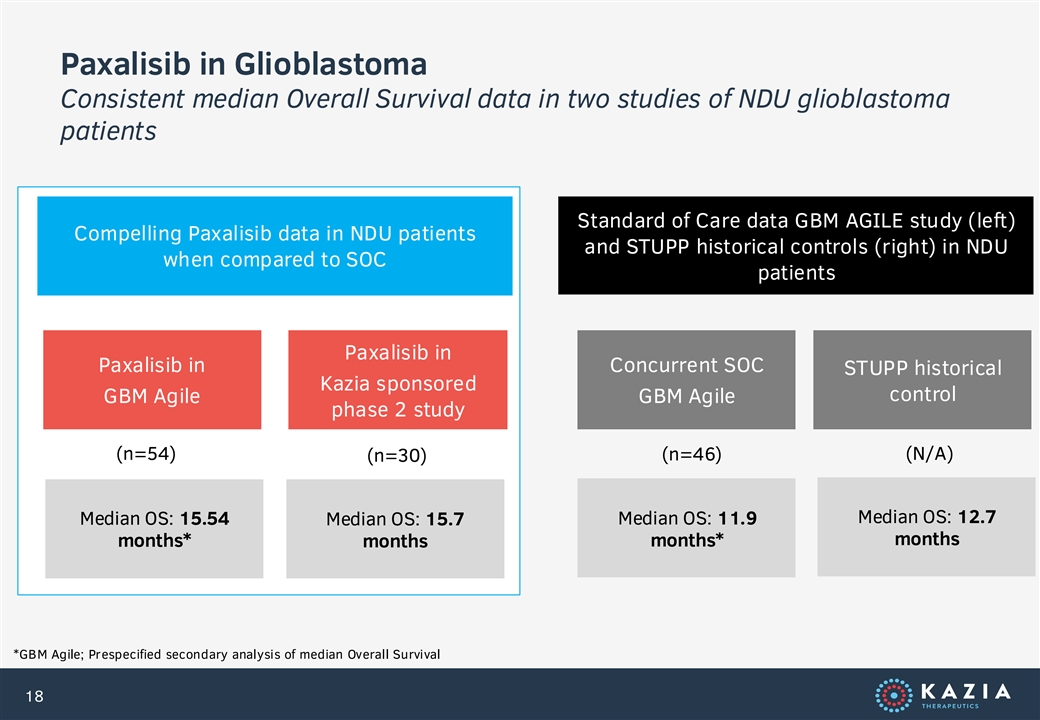
Paxalisib in Glioblastoma Consistent median Overall Survival data in two studies of NDU glioblastoma patients Standard of Care data GBM AGILE study (left) Compelling Paxalisib data in NDU patients and STUPP historical controls (right) in NDU when compared to SOC patients Paxalisib in Paxalisib in Concurrent SOC STUPP historical Kazia sponsored control GBM Agile GBM Agile phase 2 study (n=54) (N/A) (n=46) (n=30) Median OS: 12.7 Median OS: 15.54 Median OS: 15.7 Median OS: 11.9 months months* months* months *GBM Agile; Prespecified secondary analysis of median Overall Survival 18
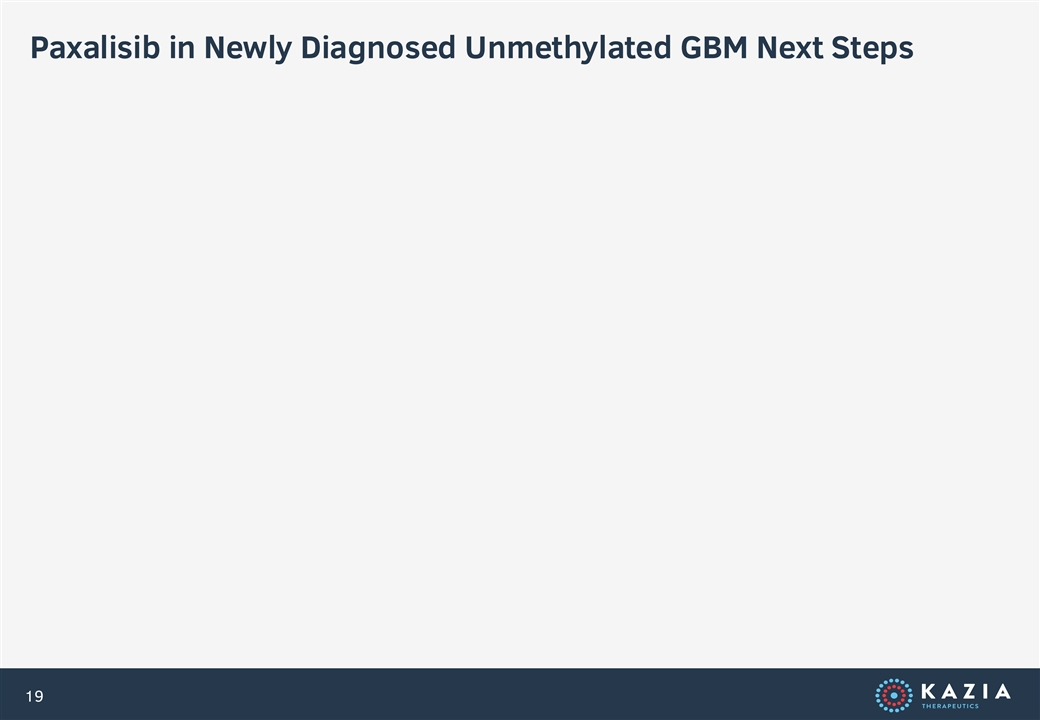
Paxalisib in Newly Diagnosed Unmethylated GBM Next Steps 19
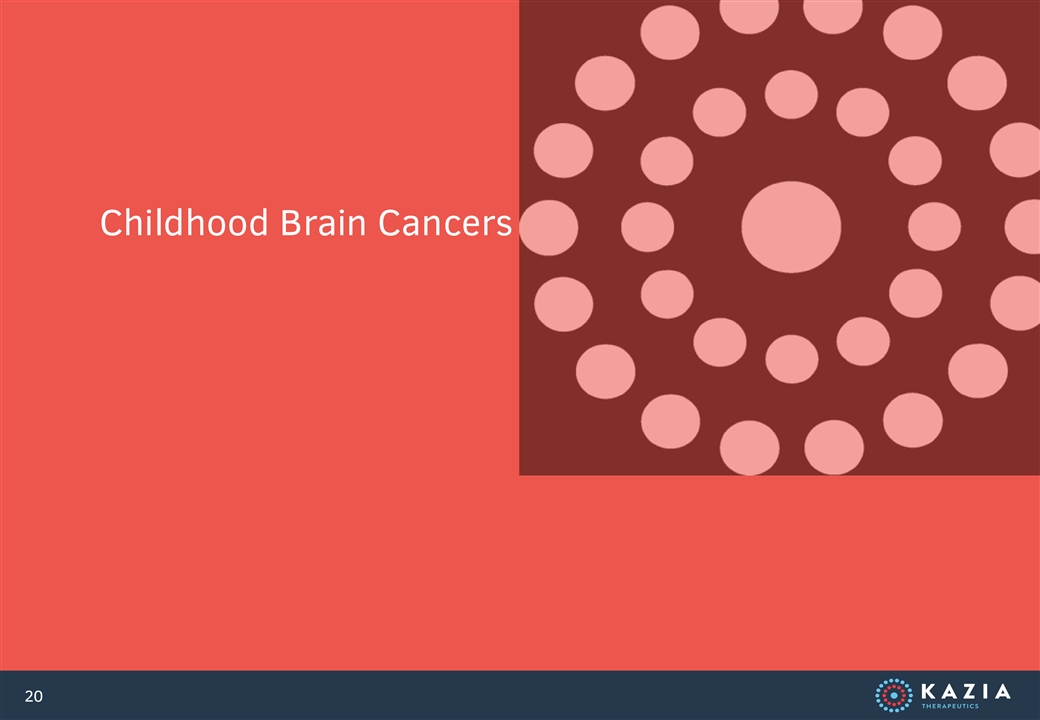
Childhood Brain Cancers 20
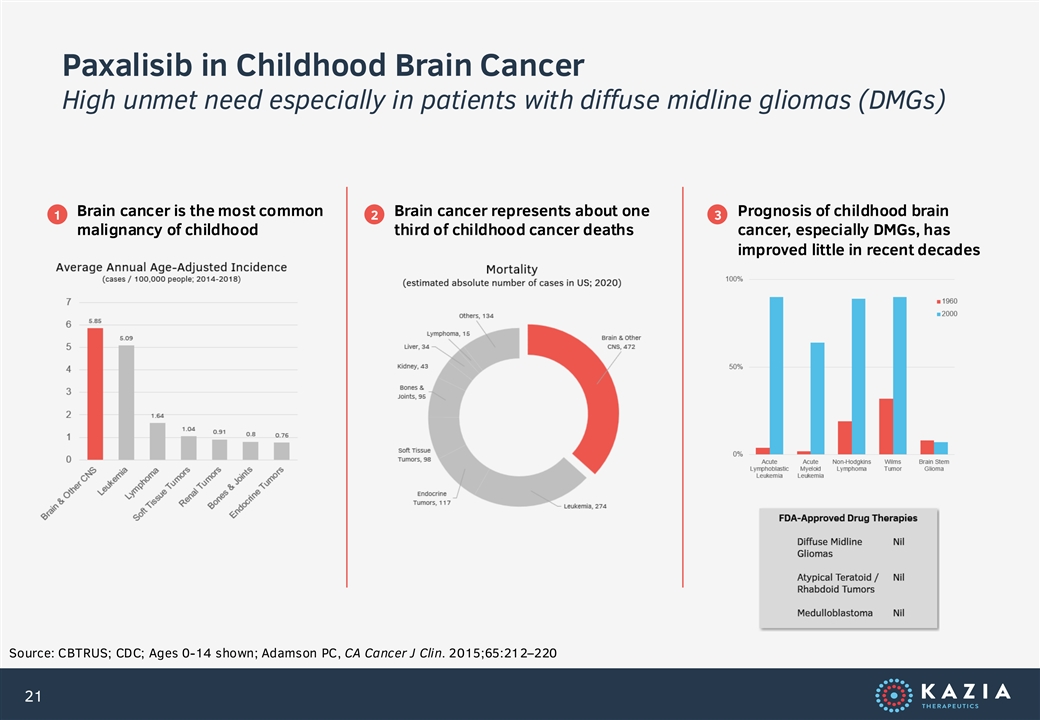
Paxalisib in Childhood Brain Cancer High unmet need especially in patients with diffuse midline gliomas (DMGs) Brain cancer is the most common Brain cancer represents about one Prognosis of childhood brain 1 2 3 malignancy of childhood third of childhood cancer deaths cancer, especially DMGs, has improved little in recent decades Source: CBTRUS; CDC; Ages 0-14 shown; Adamson PC, CA Cancer J Clin. 2015;65:212–220 21
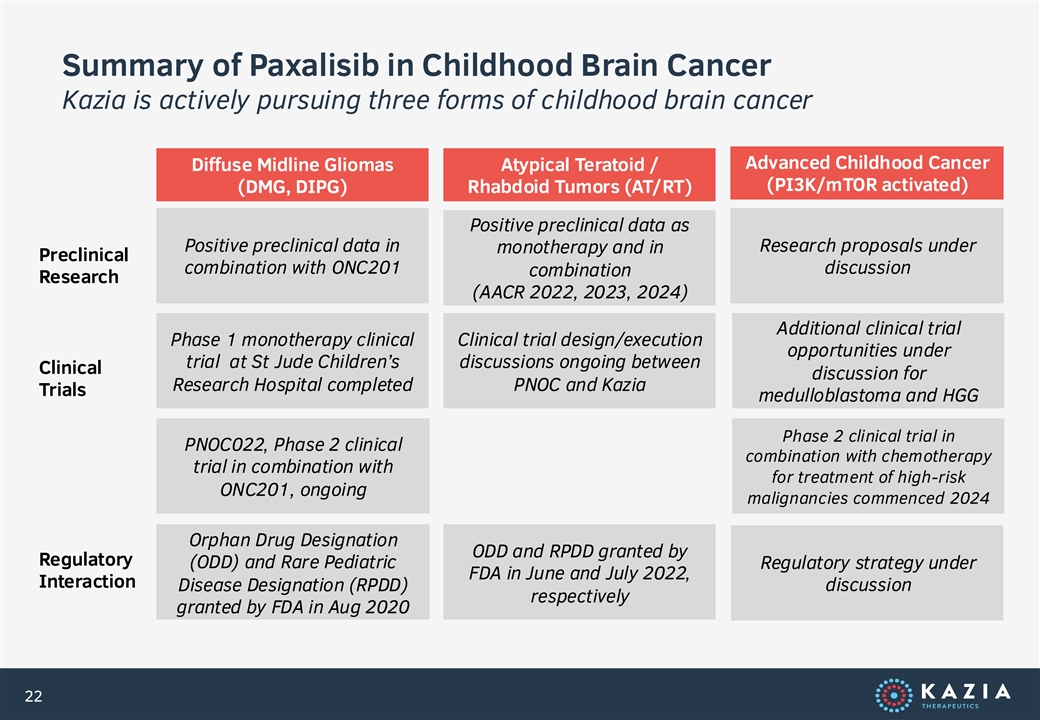
Summary of Paxalisib in Childhood Brain Cancer Kazia is actively pursuing three forms of childhood brain cancer Advanced Childhood Cancer Diffuse Midline Gliomas Atypical Teratoid / (PI3K/mTOR activated) (DMG, DIPG) Rhabdoid Tumors (AT/RT) Positive preclinical data as Positive preclinical data in Research proposals under monotherapy and in Preclinical combination with ONC201 discussion combination Research (AACR 2022, 2023, 2024) Additional clinical trial Phase 1 monotherapy clinical Clinical trial design/execution opportunities under trial at St Jude Children’s discussions ongoing between Clinical discussion for Research Hospital completed PNOC and Kazia Trials medulloblastoma and HGG Phase 2 clinical trial in PNOC022, Phase 2 clinical combination with chemotherapy trial in combination with for treatment of high-risk ONC201, ongoing malignancies commenced 2024 Orphan Drug Designation ODD and RPDD granted by Regulatory (ODD) and Rare Pediatric Regulatory strategy under FDA in June and July 2022, Interaction discussion Disease Designation (RPDD) respectively granted by FDA in Aug 2020 22
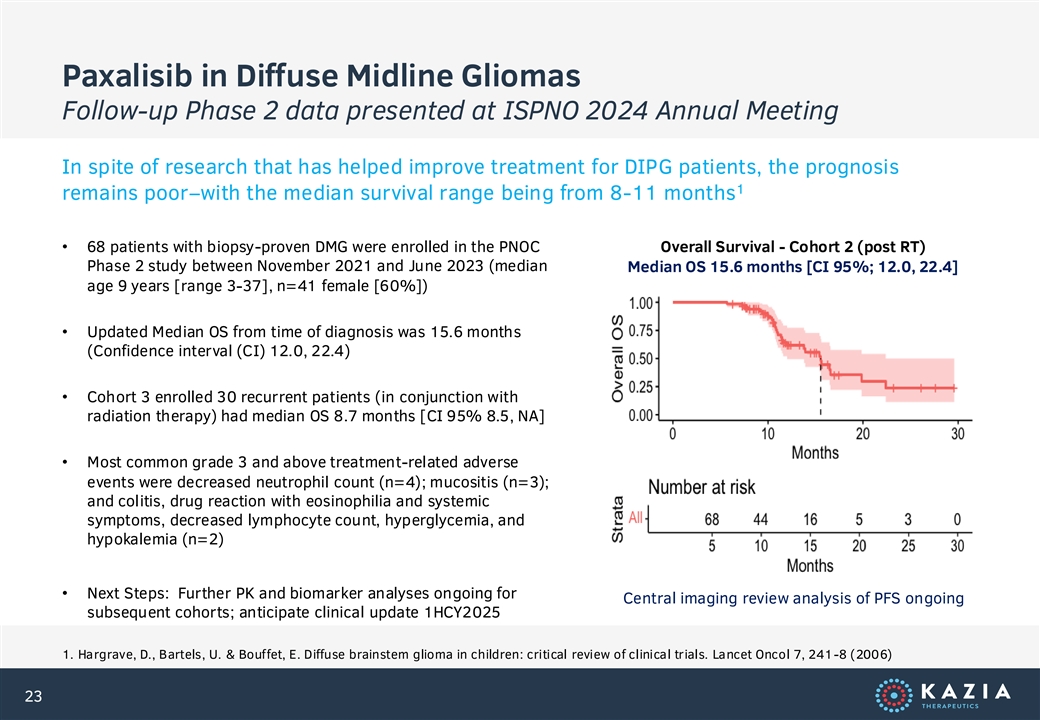
Paxalisib in Diffuse Midline Gliomas Follow-up Phase 2 data presented at ISPNO 2024 Annual Meeting In spite of research that has helped improve treatment for DIPG patients, the prognosis 1 remains poor–with the median survival range being from 8-11 months • 68 patients with biopsy-proven DMG were enrolled in the PNOC Overall Survival - Cohort 2 (post RT) Phase 2 study between November 2021 and June 2023 (median Median OS 15.6 months [CI 95%; 12.0, 22.4] age 9 years [range 3-37], n=41 female [60%]) • Updated Median OS from time of diagnosis was 15.6 months (Confidence interval (CI) 12.0, 22.4) • Cohort 3 enrolled 30 recurrent patients (in conjunction with radiation therapy) had median OS 8.7 months [CI 95% 8.5, NA] • Most common grade 3 and above treatment-related adverse events were decreased neutrophil count (n=4); mucositis (n=3); and colitis, drug reaction with eosinophilia and systemic symptoms, decreased lymphocyte count, hyperglycemia, and hypokalemia (n=2) • Next Steps: Further PK and biomarker analyses ongoing for Central imaging review analysis of PFS ongoing subsequent cohorts; anticipate clinical update 1HCY2025 1. Hargrave, D., Bartels, U. & Bouffet, E. Diffuse brainstem glioma in children: critical review of clinical trials. Lancet Oncol 7, 241-8 (2006) 23
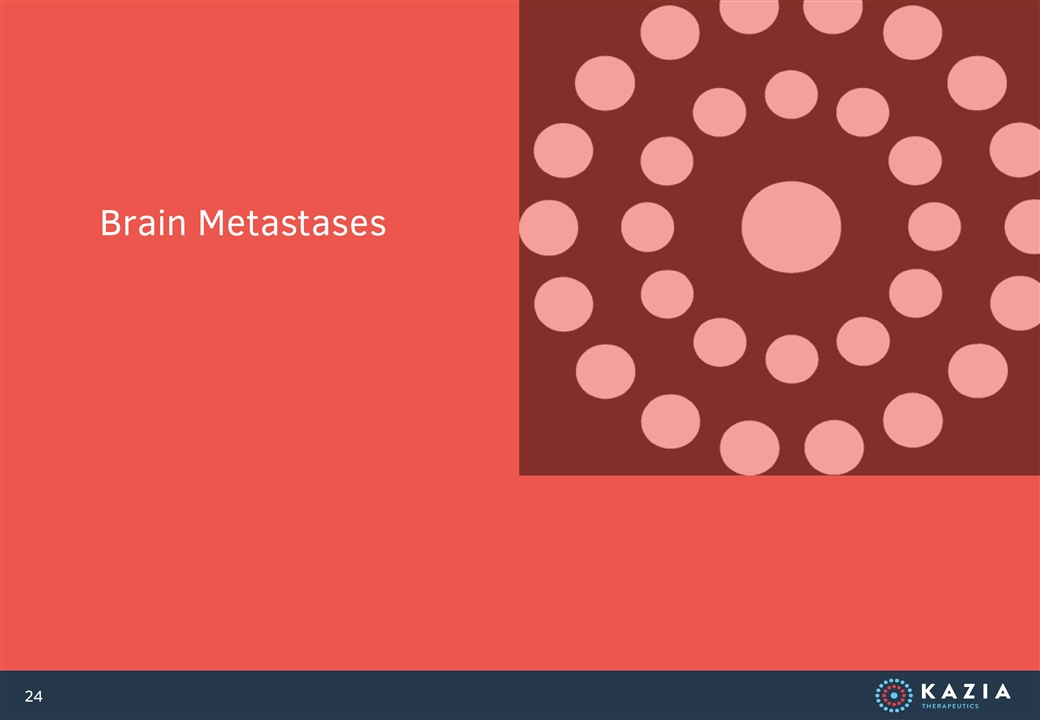
Brain Metastases 24
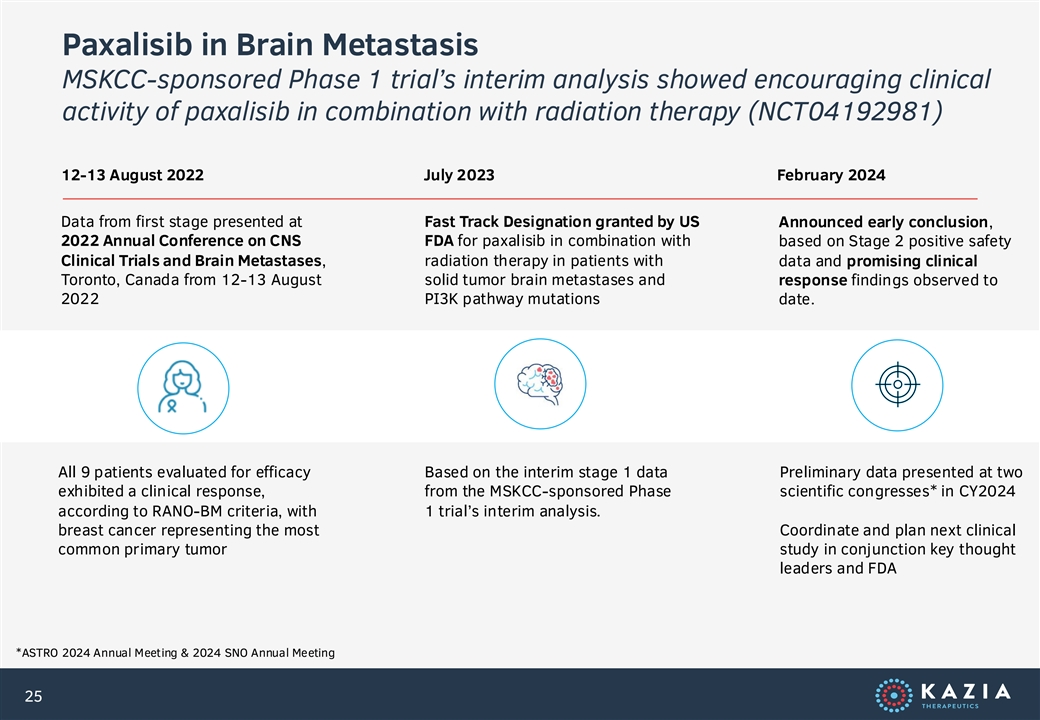
Paxalisib in Brain Metastasis MSKCC-sponsored Phase 1 trial’s interim analysis showed encouraging clinical activity of paxalisib in combination with radiation therapy (NCT04192981) 12-13 August 2022 July 2023 February 2024 Data from first stage presented at Fast Track Designation granted by US Announced early conclusion, 2022 Annual Conference on CNS FDA for paxalisib in combination with based on Stage 2 positive safety Clinical Trials and Brain Metastases, radiation therapy in patients with data and promising clinical Toronto, Canada from 12-13 August solid tumor brain metastases and response findings observed to 2022 PI3K pathway mutations date. All 9 patients evaluated for efficacy Based on the interim stage 1 data Preliminary data presented at two exhibited a clinical response, from the MSKCC-sponsored Phase scientific congresses* in CY2024 according to RANO-BM criteria, with 1 trial’s interim analysis. breast cancer representing the most Coordinate and plan next clinical common primary tumor study in conjunction key thought leaders and FDA *ASTRO 2024 Annual Meeting & 2024 SNO Annual Meeting 25
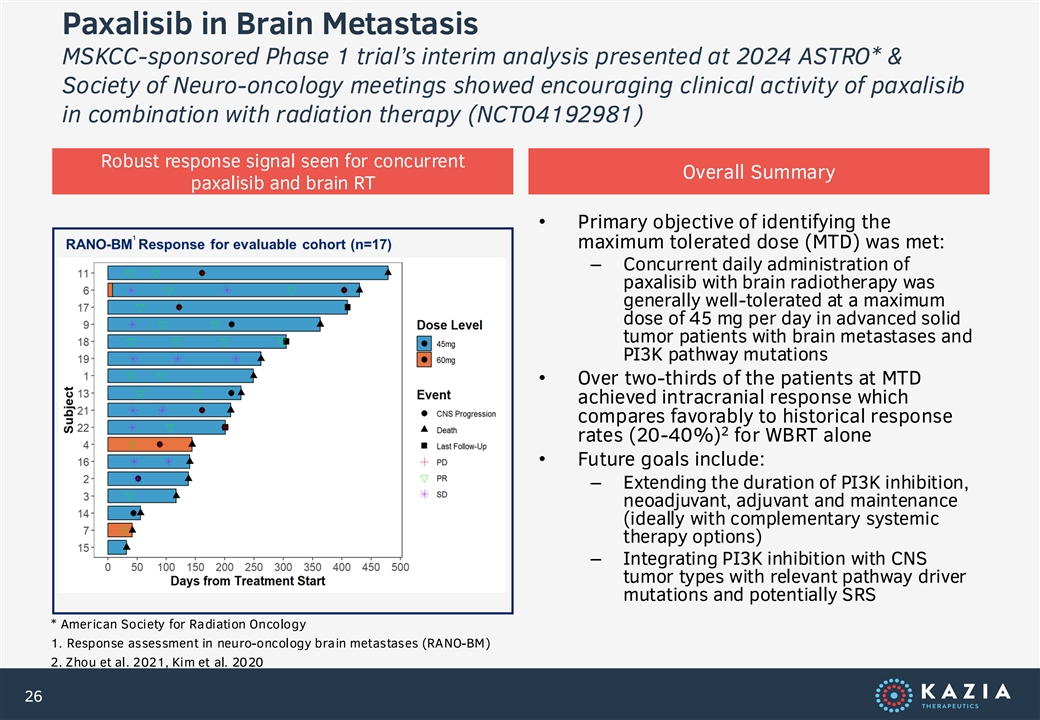
Paxalisib in Brain Metastasis MSKCC-sponsored Phase 1 trial’s interim analysis presented at 2024 ASTRO* & Society of Neuro-oncology meetings showed encouraging clinical activity of paxalisib in combination with radiation therapy (NCT04192981) Robust response signal seen for concurrent Overall Summary paxalisib and brain RT • Primary objective of identifying the 1 maximum tolerated dose (MTD) was met: – Concurrent daily administration of paxalisib with brain radiotherapy was generally well-tolerated at a maximum dose of 45 mg per day in advanced solid tumor patients with brain metastases and PI3K pathway mutations • Over two-thirds of the patients at MTD achieved intracranial response which compares favorably to historical response 2 rates (20-40%) for WBRT alone • Future goals include: – Extending the duration of PI3K inhibition, neoadjuvant, adjuvant and maintenance (ideally with complementary systemic therapy options) – Integrating PI3K inhibition with CNS tumor types with relevant pathway driver mutations and potentially SRS * American Society for Radiation Oncology 1. Response assessment in neuro-oncology brain metastases (RANO-BM) 2. Zhou et al. 2021, Kim et al. 2020 26
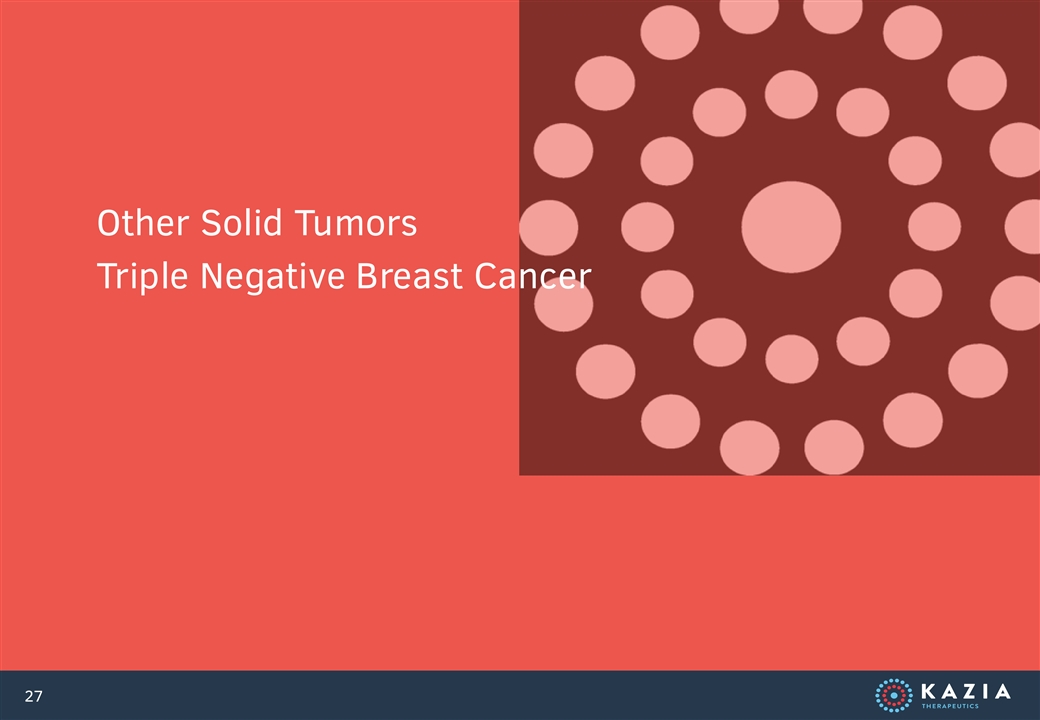
Other Solid Tumors Triple Negative Breast Cancer 27
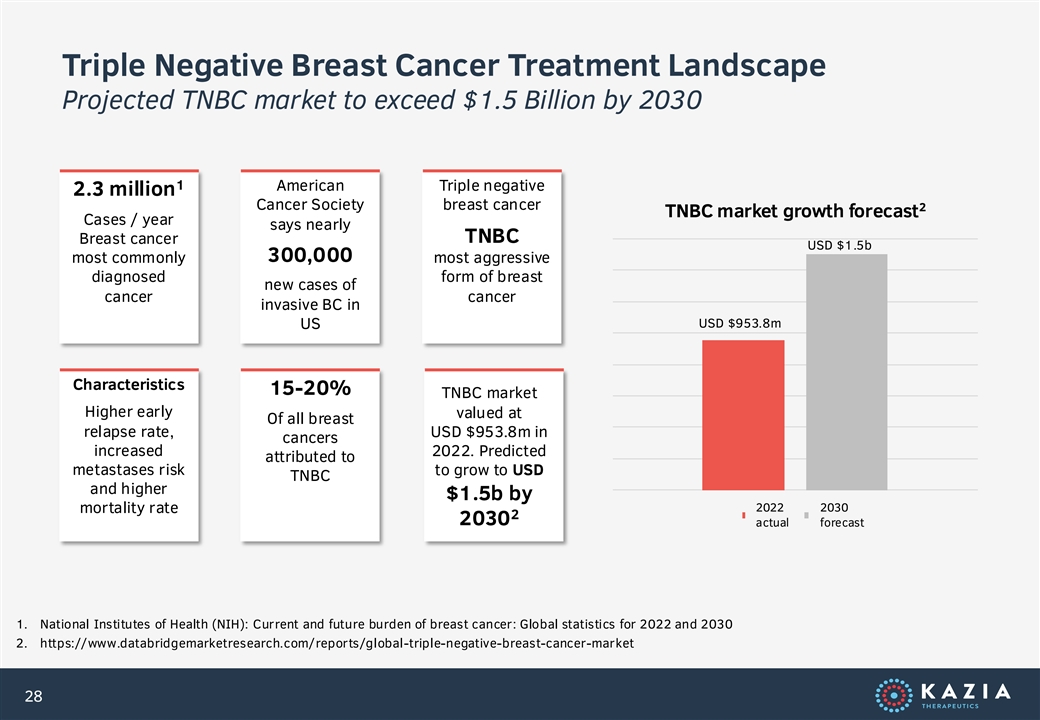
Triple Negative Breast Cancer Treatment Landscape Projected TNBC market to exceed $1.5 Billion by 2030 1 American Triple negative 2.3 million Cancer Society breast cancer 2 TNBC market growth forecast Cases / year says nearly TNBC Breast cancer USD $1.5b most commonly 300,000 most aggressive diagnosed form of breast new cases of cancer cancer invasive BC in USD $953.8m US Characteristics 15-20% TNBC market Higher early valued at Of all breast relapse rate, USD $953.8m in cancers increased 2022. Predicted attributed to metastases risk to grow to USD TNBC and higher $1.5b by 2022 2030 mortality rate 2 Series1 Series2 2030 actual forecast 1. National Institutes of Health (NIH): Current and future burden of breast cancer: Global statistics for 2022 and 2030 2. https://www.databridgemarketresearch.com/reports/global-triple-negative-breast-cancer-market 28
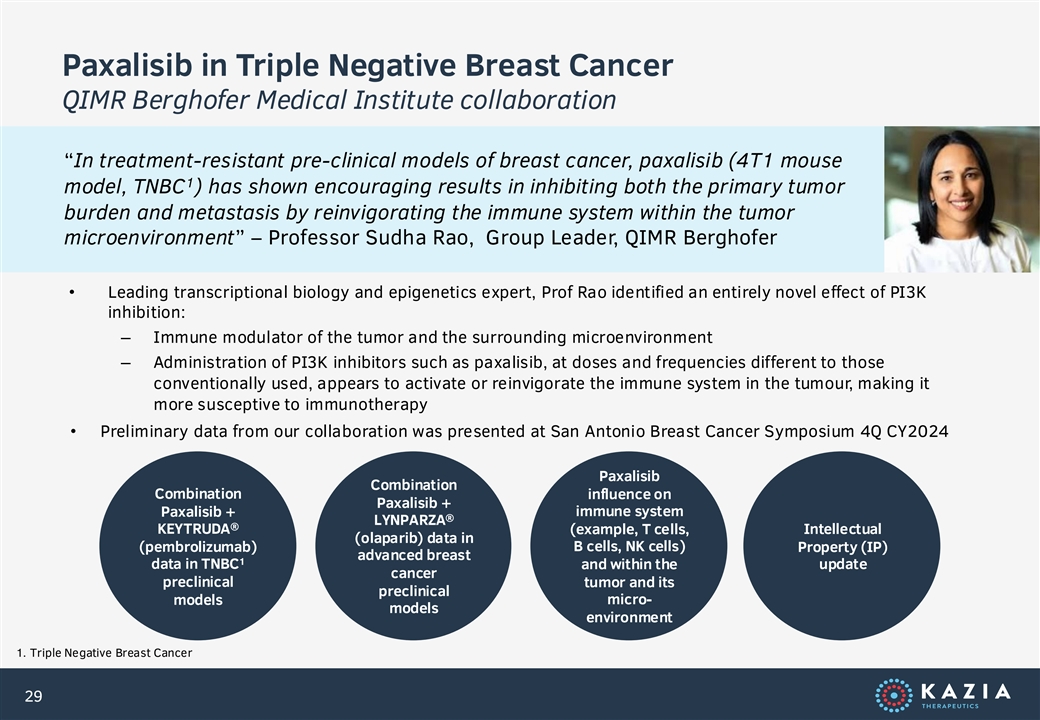
Paxalisib in Triple Negative Breast Cancer QIMR Berghofer Medical Institute collaboration “In treatment-resistant pre-clinical models of breast cancer, paxalisib (4T1 mouse 1 model, TNBC ) has shown encouraging results in inhibiting both the primary tumor burden and metastasis by reinvigorating the immune system within the tumor microenvironment” – Professor Sudha Rao, Group Leader, QIMR Berghofer • Leading transcriptional biology and epigenetics expert, Prof Rao identified an entirely novel effect of PI3K inhibition: – Immune modulator of the tumor and the surrounding microenvironment – Administration of PI3K inhibitors such as paxalisib, at doses and frequencies different to those conventionally used, appears to activate or reinvigorate the immune system in the tumour, making it more susceptive to immunotherapy • Preliminary data from our collaboration was presented at San Antonio Breast Cancer Symposium 4Q CY2024 Paxalisib Combination Combination influence on Paxalisib + immune system Paxalisib + ® LYNPARZA ® KEYTRUDA (example, T cells, Intellectual (olaparib) data in (pembrolizumab) B cells, NK cells) Property (IP) advanced breast 1 data in TNBC and within the update cancer preclinical tumor and its preclinical micro- models models environment 1. Triple Negative Breast Cancer 29
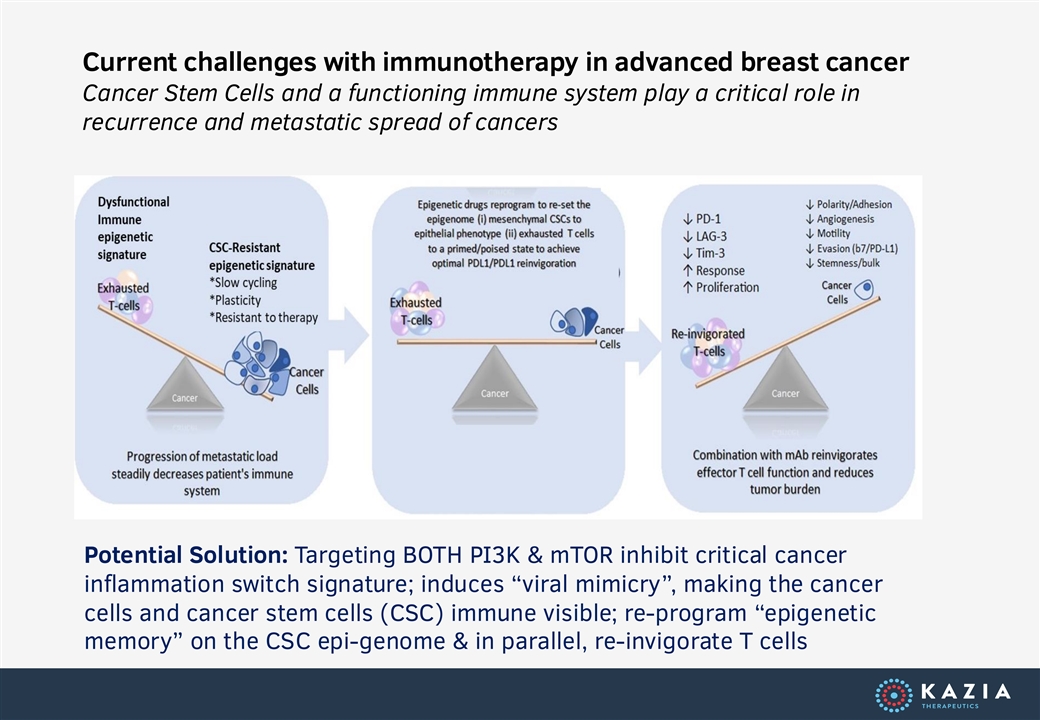
Current challenges with immunotherapy in advanced breast cancer Cancer Stem Cells and a functioning immune system play a critical role in recurrence and metastatic spread of cancers Potential Solution: Targeting BOTH PI3K & mTOR inhibit critical cancer inflammation switch signature; induces “viral mimicry”, making the cancer cells and cancer stem cells (CSC) immune visible; re-program “epigenetic memory” on the CSC epi-genome & in parallel, re-invigorate T cells
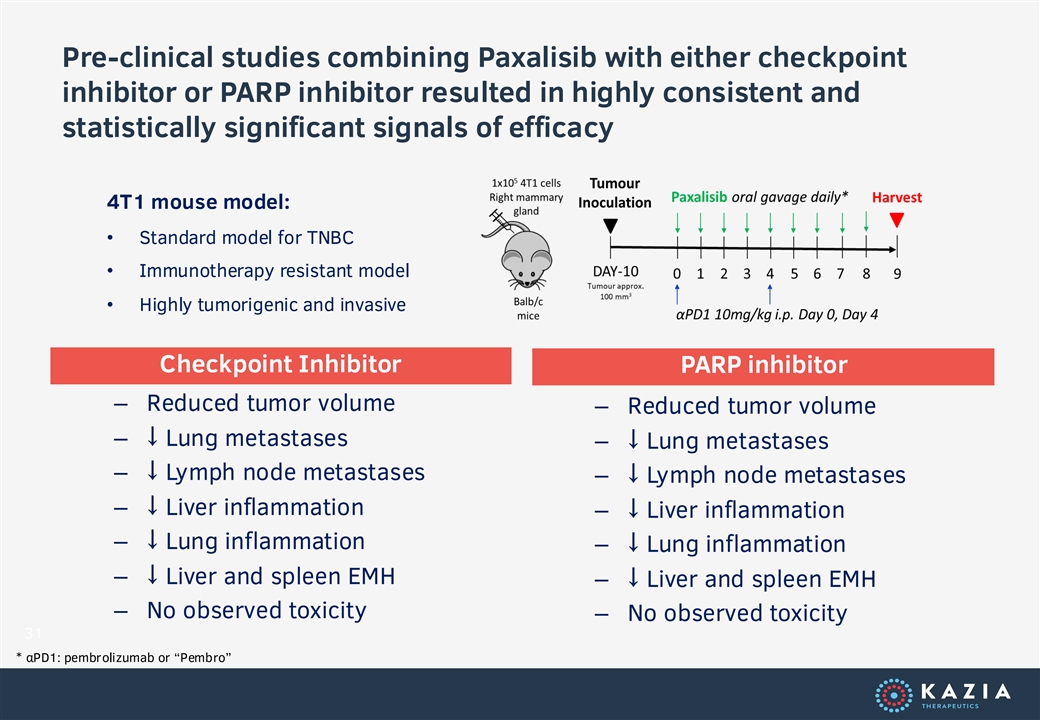
Pre-clinical studies combining Paxalisib with either checkpoint inhibitor or PARP inhibitor resulted in highly consistent and statistically significant signals of efficacy 4T1 mouse model: • Standard model for TNBC • Immunotherapy resistant model • Highly tumorigenic and invasive Checkpoint Inhibitor PARP inhibitor – Reduced tumor volume – Reduced tumor volume – ↓ Lung metastases – ↓ Lung metastases – ↓ Lymph node metastases – ↓ Lymph node metastases – ↓ Liver inflammation – ↓ Liver inflammation – ↓ Lung inflammation – ↓ Lung inflammation – ↓ Liver and spleen EMH – ↓ Liver and spleen EMH – No observed toxicity – No observed toxicity 31 * αPD1: pembrolizumab or “Pembro”
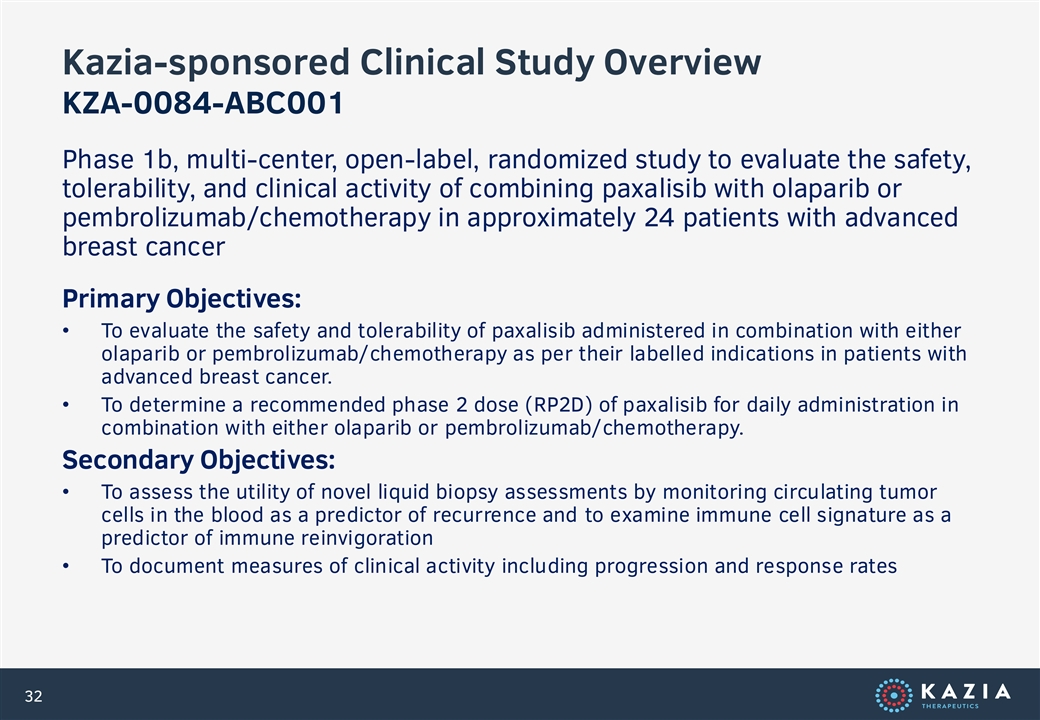
Kazia-sponsored Clinical Study Overview KZA-0084-ABC001 Phase 1b, multi-center, open-label, randomized study to evaluate the safety, tolerability, and clinical activity of combining paxalisib with olaparib or pembrolizumab/chemotherapy in approximately 24 patients with advanced breast cancer Primary Objectives: • To evaluate the safety and tolerability of paxalisib administered in combination with either olaparib or pembrolizumab/chemotherapy as per their labelled indications in patients with advanced breast cancer. • To determine a recommended phase 2 dose (RP2D) of paxalisib for daily administration in combination with either olaparib or pembrolizumab/chemotherapy. Secondary Objectives: • To assess the utility of novel liquid biopsy assessments by monitoring circulating tumor cells in the blood as a predictor of recurrence and to examine immune cell signature as a predictor of immune reinvigoration • To document measures of clinical activity including progression and response rates 32
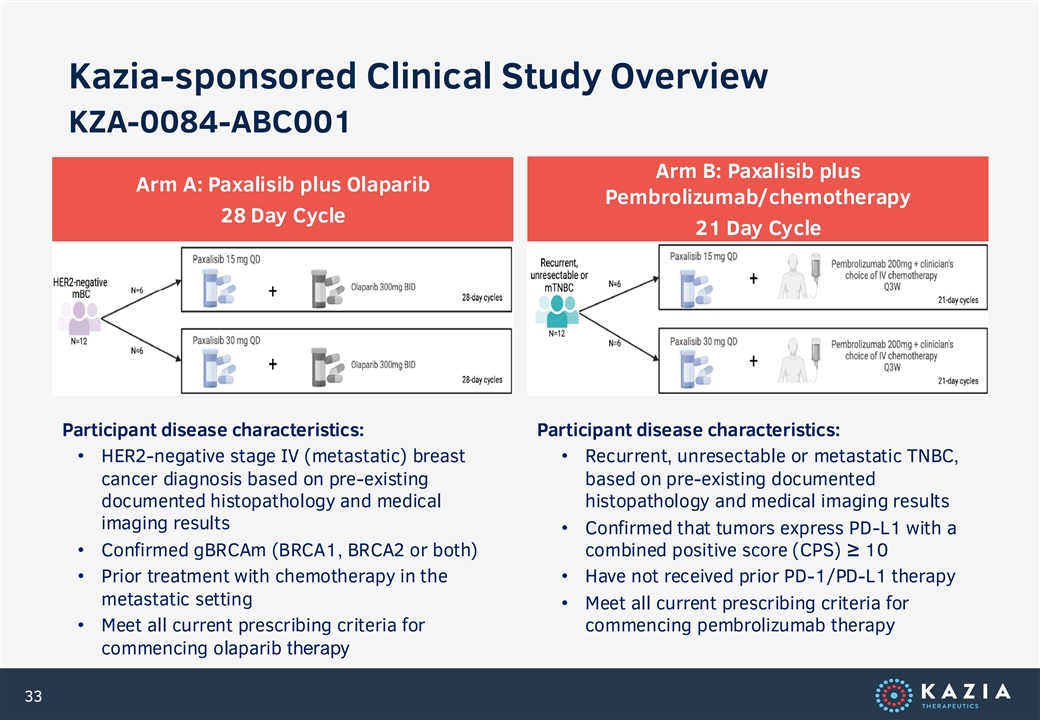
Kazia-sponsored Clinical Study Overview KZA-0084-ABC001 Arm B: Paxalisib plus Arm A: Paxalisib plus Olaparib Pembrolizumab/chemotherapy 28 Day Cycle 21 Day Cycle 1 Participant disease characteristics: Participant disease characteristics: • HER2-negative stage IV (metastatic) breast • Recurrent, unresectable or metastatic TNBC, cancer diagnosis based on pre-existing based on pre-existing documented documented histopathology and medical histopathology and medical imaging results imaging results • Confirmed that tumors express PD-L1 with a • Confirmed gBRCAm (BRCA1, BRCA2 or both) combined positive score (CPS) ≥ 10 • Prior treatment with chemotherapy in the • Have not received prior PD-1/PD-L1 therapy metastatic setting • Meet all current prescribing criteria for • Meet all current prescribing criteria for commencing pembrolizumab therapy commencing olaparib therapy 33
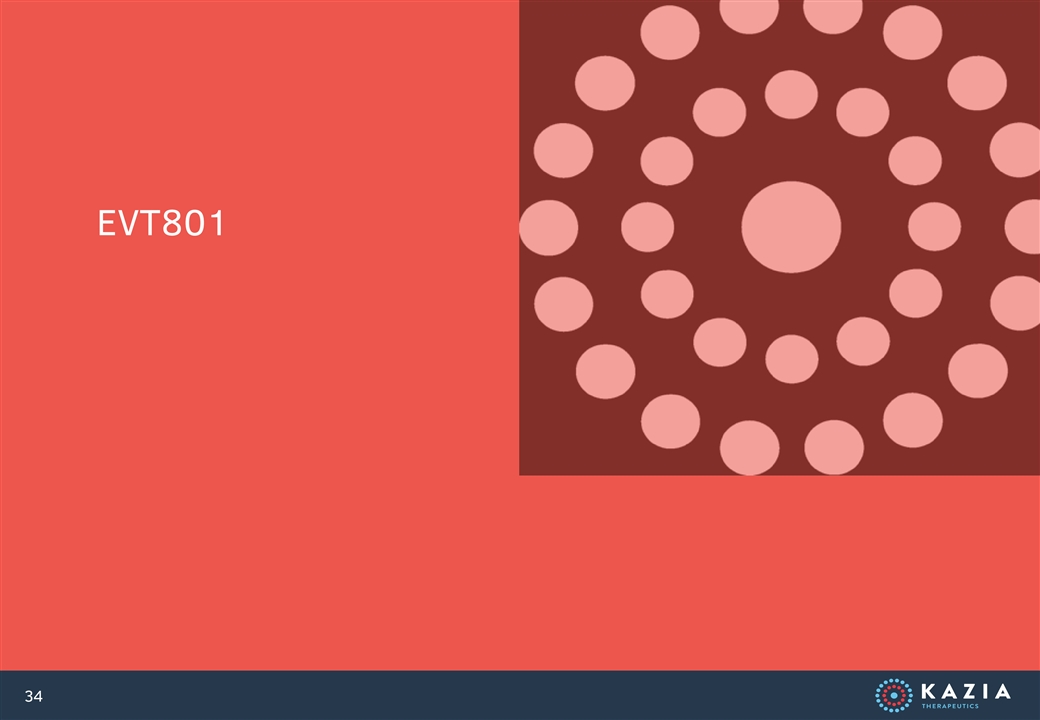
EVT801 34
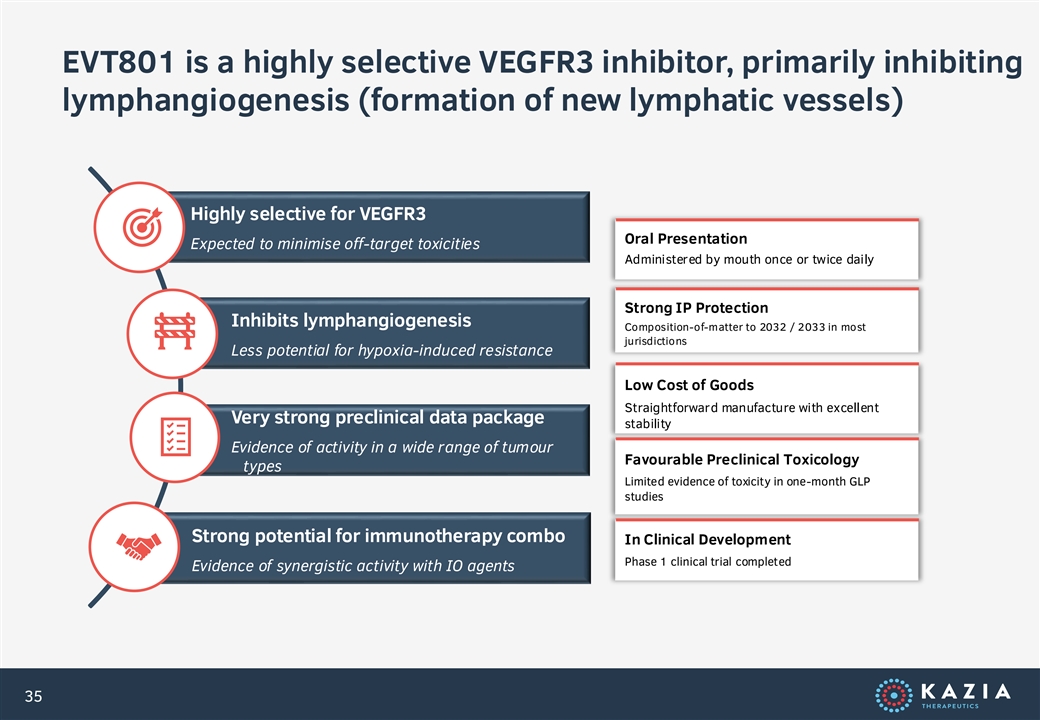
EVT801 is a highly selective VEGFR3 inhibitor, primarily inhibiting lymphangiogenesis (formation of new lymphatic vessels) Highly selective for VEGFR3 Oral Presentation Expected to minimise off-target toxicities Administered by mouth once or twice daily Strong IP Protection Inhibits lymphangiogenesis Composition-of-matter to 2032 / 2033 in most jurisdictions Less potential for hypoxia-induced resistance Low Cost of Goods Straightforward manufacture with excellent Very strong preclinical data package stability Evidence of activity in a wide range of tumour Favourable Preclinical Toxicology types Limited evidence of toxicity in one-month GLP studies Strong potential for immunotherapy combo In Clinical Development Phase 1 clinical trial completed Evidence of synergistic activity with IO agents 35
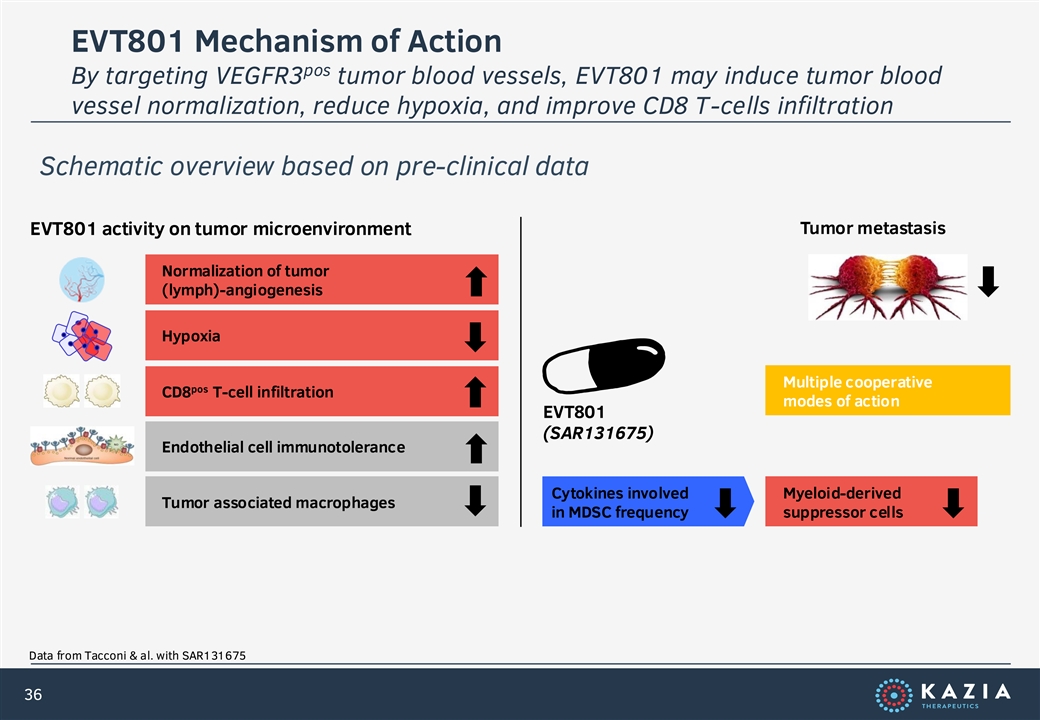
EVT801 Mechanism of Action pos By targeting VEGFR3 tumor blood vessels, EVT801 may induce tumor blood vessel normalization, reduce hypoxia, and improve CD8 T-cells infiltration Schematic overview based on pre-clinical data EVT801 activity on tumor microenvironment Tumor metastasis Normalization of tumor (lymph)-angiogenesis Hypoxia Multiple cooperative pos CD8 T-cell infiltration modes of action EVT801 (SAR131675) Endothelial cell immunotolerance Cytokines involved Myeloid-derived Tumor associated macrophages in MDSC frequency suppressor cells Data from Tacconi & al. with SAR131675 36
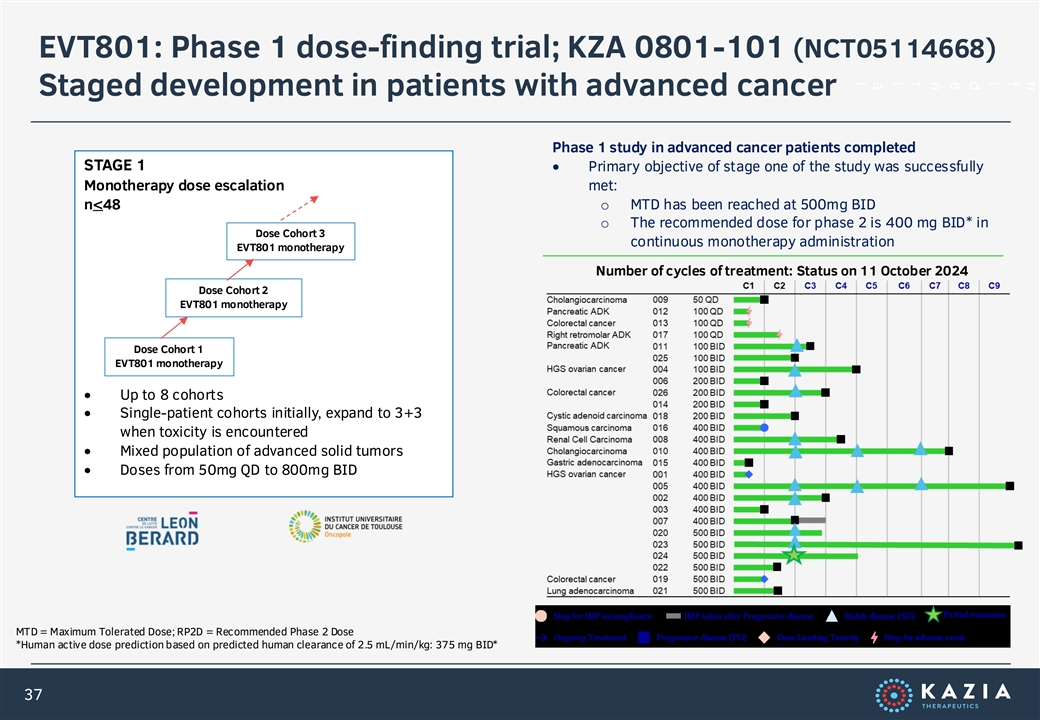
o n f i d e n t i a l EVT801: Phase 1 dose-finding trial; KZA 0801-101 (NCT05114668) Staged development in patients with advanced cancer Phase 1 study in advanced cancer patients completed STAGE 1 • Primary objective of stage one of the study was successfully Monotherapy dose escalation met: n<48 o MTD has been reached at 500mg BID o The recommended dose for phase 2 is 400 mg BID* in Dose Cohort 3 continuous monotherapy administration EVT801 monotherapy Number of cycles of treatment: Status on 11 October 2024 Dose Cohort 2 EVT801 monotherapy Dose Cohort 1 EVT801 monotherapy • Up to 8 cohorts • Single-patient cohorts initially, expand to 3+3 when toxicity is encountered • Mixed population of advanced solid tumors • Doses from 50mg QD to 800mg BID MTD = Maximum Tolerated Dose; RP2D = Recommended Phase 2 Dose *Human active dose prediction based on predicted human clearance of 2.5 mL/min/kg: 375 mg BID* 37
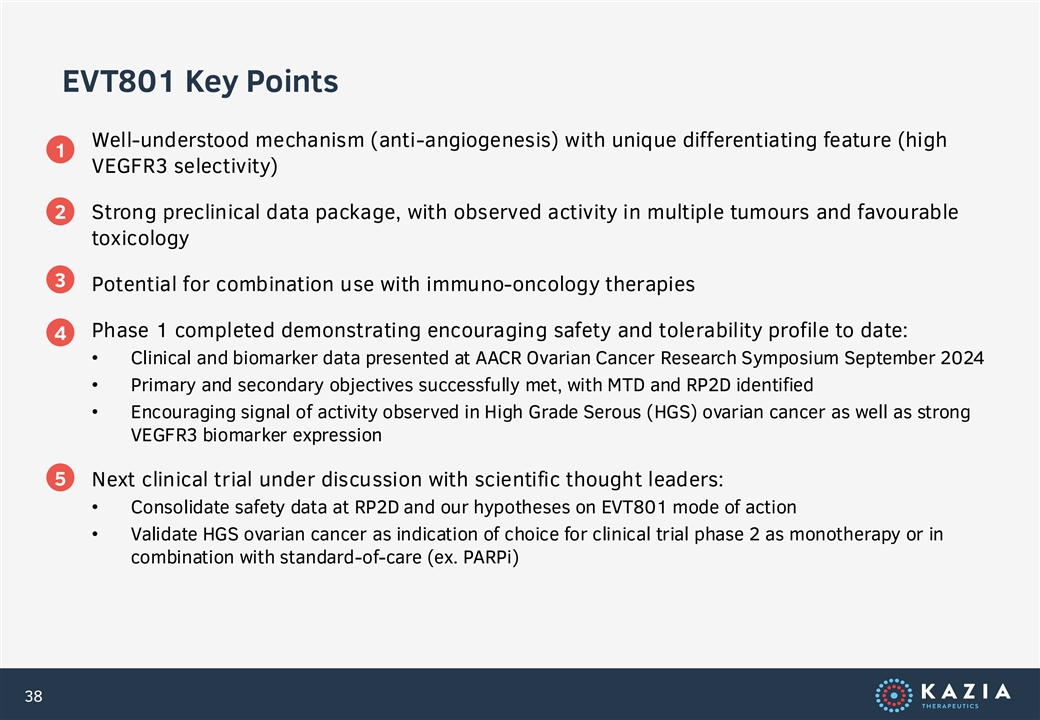
EVT801 Key Points Well-understood mechanism (anti-angiogenesis) with unique differentiating feature (high 1 VEGFR3 selectivity) 2 Strong preclinical data package, with observed activity in multiple tumours and favourable toxicology 3 Potential for combination use with immuno-oncology therapies Phase 1 completed demonstrating encouraging safety and tolerability profile to date: 4 • Clinical and biomarker data presented at AACR Ovarian Cancer Research Symposium September 2024 • Primary and secondary objectives successfully met, with MTD and RP2D identified • Encouraging signal of activity observed in High Grade Serous (HGS) ovarian cancer as well as strong VEGFR3 biomarker expression 5 Next clinical trial under discussion with scientific thought leaders: • Consolidate safety data at RP2D and our hypotheses on EVT801 mode of action • Validate HGS ovarian cancer as indication of choice for clinical trial phase 2 as monotherapy or in combination with standard-of-care (ex. PARPi) 38

2024 Corporate Update 39
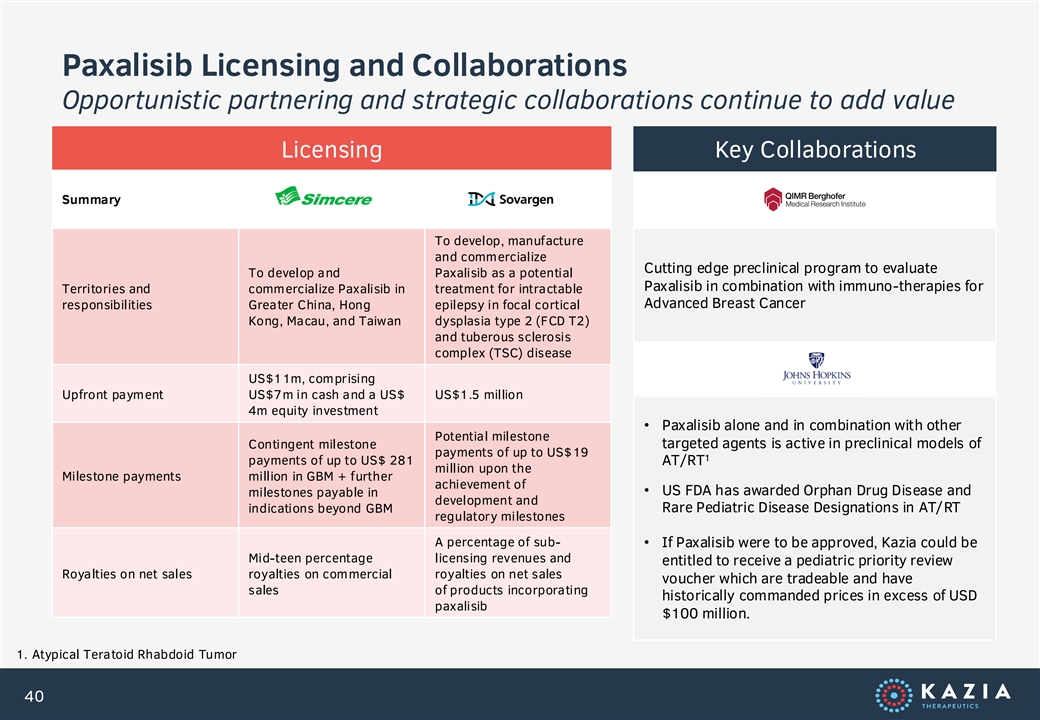
Paxalisib Licensing and Collaborations Opportunistic partnering and strategic collaborations continue to add value Licensing Key Collaborations Summary To develop, manufacture and commercialize Cutting edge preclinical program to evaluate To develop and Paxalisib as a potential Paxalisib in combination with immuno-therapies for Territories and commercialize Paxalisib in treatment for intractable Advanced Breast Cancer responsibilities Greater China, Hong epilepsy in focal cortical Kong, Macau, and Taiwan dysplasia type 2 (FCD T2) and tuberous sclerosis complex (TSC) disease US$11m, comprising Upfront payment US$7m in cash and a US$ US$1.5 million 4m equity investment • Paxalisib alone and in combination with other Potential milestone targeted agents is active in preclinical models of Contingent milestone payments of up to US$19 1 payments of up to US$ 281 AT/RT million upon the Milestone payments million in GBM + further achievement of • US FDA has awarded Orphan Drug Disease and milestones payable in development and Rare Pediatric Disease Designations in AT/RT indications beyond GBM regulatory milestones A percentage of sub- • If Paxalisib were to be approved, Kazia could be Mid-teen percentage licensing revenues and entitled to receive a pediatric priority review Royalties on net sales royalties on commercial royalties on net sales voucher which are tradeable and have sales of products incorporating historically commanded prices in excess of USD paxalisib $100 million. 1. Atypical Teratoid Rhabdoid Tumor 40
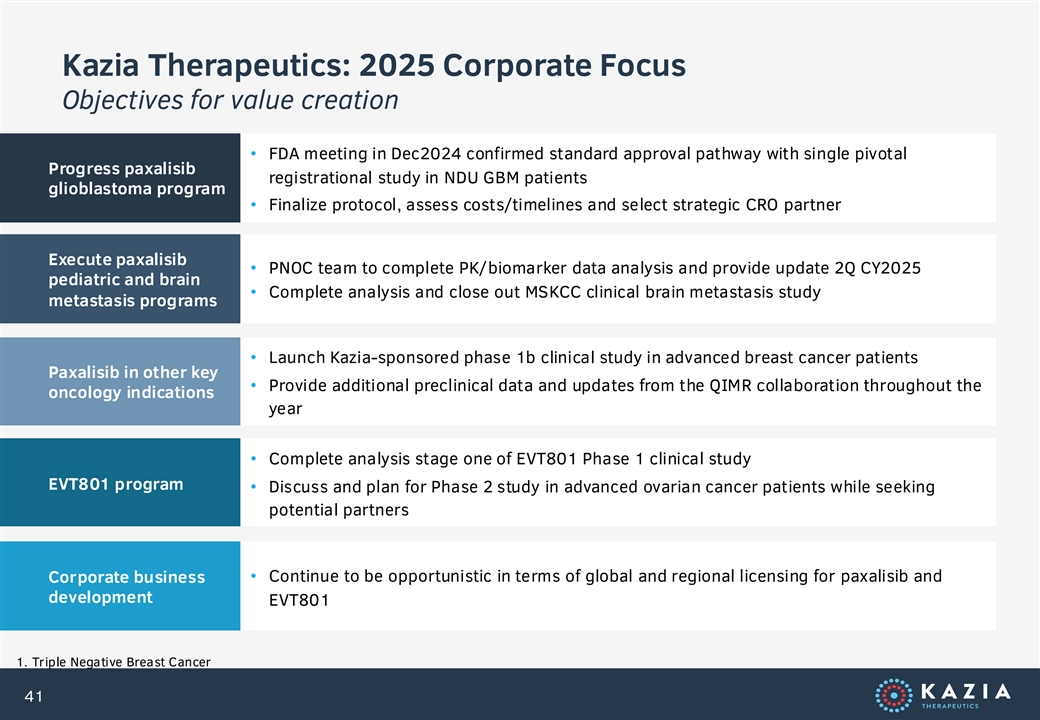
Kazia Therapeutics: 2025 Corporate Focus Objectives for value creation • FDA meeting in Dec2024 confirmed standard approval pathway with single pivotal Progress paxalisib registrational study in NDU GBM patients glioblastoma program • Finalize protocol, assess costs/timelines and select strategic CRO partner Execute paxalisib • PNOC team to complete PK/biomarker data analysis and provide update 2Q CY2025 pediatric and brain • Complete analysis and close out MSKCC clinical brain metastasis study metastasis programs • Launch Kazia-sponsored phase 1b clinical study in advanced breast cancer patients Paxalisib in other key • Provide additional preclinical data and updates from the QIMR collaboration throughout the oncology indications year • Complete analysis stage one of EVT801 Phase 1 clinical study EVT801 program • Discuss and plan for Phase 2 study in advanced ovarian cancer patients while seeking potential partners • Continue to be opportunistic in terms of global and regional licensing for paxalisib and Corporate business development EVT801 1. Triple Negative Breast Cancer 41

www.kaziatherapeutics.com info@kaziatherapeutics.com










































